TUESDAY
APRIL 15 - 2014
Migrant
Hunting
I had a
productive morning hunting for migrant birds, adding
three species to my year list. Starting at Brook
Meadow, Chiffchaffs and Blackcaps were singing well as
usual, but I drew a blank on Whitethroat. It is still
a bit early for Whitethroat which usually arrive on
Brook Meadow in late April.
Thorney
Island
I had better
luck when I checked the old NRA track across North
Thorney where a couple of Swallows were flying
around the stables on the old Marina Farm site - my
first of the year. As I watched they came across to
where I was standing and perched conveniently for a
photo on the overhead cables.
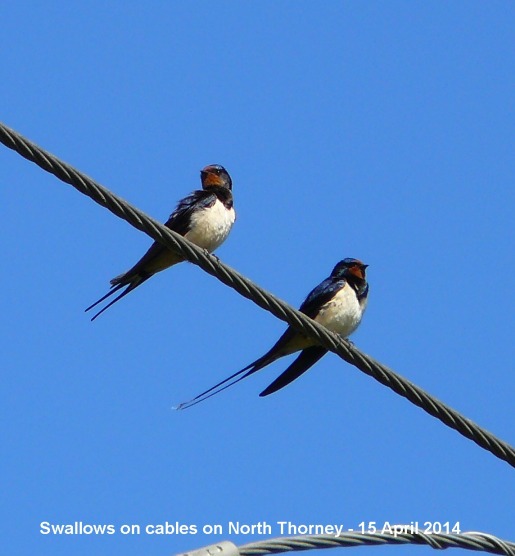
My second new migrant
of the morning was Sedge Warbler, which I first
heard briefly from the reeds to the south of the NRA
track. However, I heard another two singing clearly
from the reeds on the way down to Thorney Little
Deeps. There was no sound of Reed Warbler, which
usually arrive later than Sedge Warbler.
Amazingly, I actually saw a Cetti's Warbler
singing from a bush near Little Deeps. I was so
astonished to see this very elusive bird that it had
gone by the time I got my camera out.
Marlpit
Lane
I got my third
migrant of the morning as I walked up Marlpit Lane
from parking the car near the amenity tip. It was not
actually what I had hoped for, ie a Nightingale, but a
Willow Warbler, which was almost as good. I
listened to its short sweet song for a few minutes, a
short falling cadence, repeated every 6 seconds or
so.
I walked the whole length of Marlpit Lane listening
intently for the distinctive notes of a Nightingale,
but there was nothing to be heard apart from
Chiffchaffs and Blackcaps.
I had a wander around the open wasteland area to the
east of the lane where there was masses of
Ground-ivy in flower everywhere. This is a very
attractive plant which is often given not more than a
glance. So I took some pictures of it to give it
rightful place among the flora of the area.
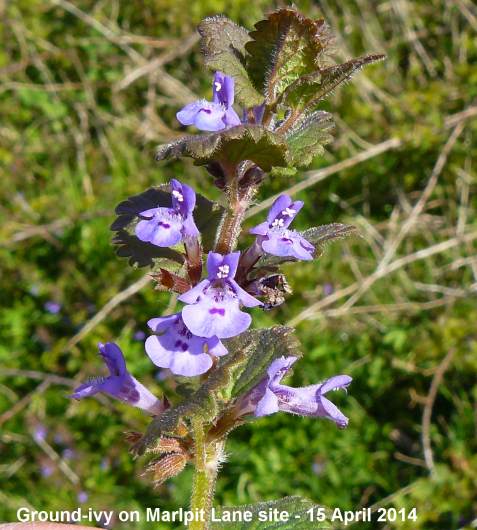
I was interested to
see a couple of Pond Skaters skimming over the
surface of one of the large puddles on the tracks of
the Marlpit Lane site. Suddenly they came together and
appeared to be mating - the first time I have ever
seen this happen.
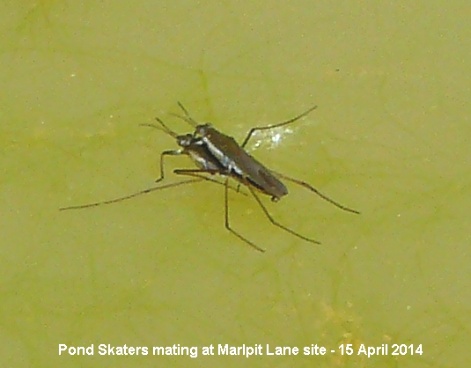
The only other flowers
to catch my attention on the Marlpit Lane site were
some small yellow daisies which reminded me of Autumn
Hawkbit though they clearly could not be that. The
flowers looked like Dandelions, but were much smaller
(around 2cm) and shorter (about 6cm). They appeared to
fit the description of what Blamey, Fitter and Fitter
(p.294) refer to as Dandelion - Section
Erythrosperma. These are our smallest
and slenderest Dandelions, flowering April-June in
warm dry and sunny habitats and include 30 different
species! They are called Lesser Dandelion in my
old Collins New Generation Flower Guide by Alastair
Fitter (p.119), which seems a very good name for it.
There are, in fact a staggering 240-250 different
species of Dandelion!!
The photo shows a view of the flowerhead from above
and below.
Racton
Park Farm
As I was in
the area I decided to have a look at Racton Park Farm
where I used to find Swallows in BTO Breeding Birds
Surveys which I did from 2006-12 on this patch.
However, there were none there today. The Rookery at
the back of the farm was noisy as usual, but I could
only see 32 nests, which is fewer than the 54 or so I
used to have in the BBS counts.
Water
Voles
Rob Foord and
Tina, my next door neighbours, walked through Brook
Meadow last night and were delighted to see a Water
Vole at about 8.15pm from the observation fence. It
was Tina's first!
Malcolm Phillips saw what was probably the same Water
Vole this afternoon and got the following photo of it
swimming.
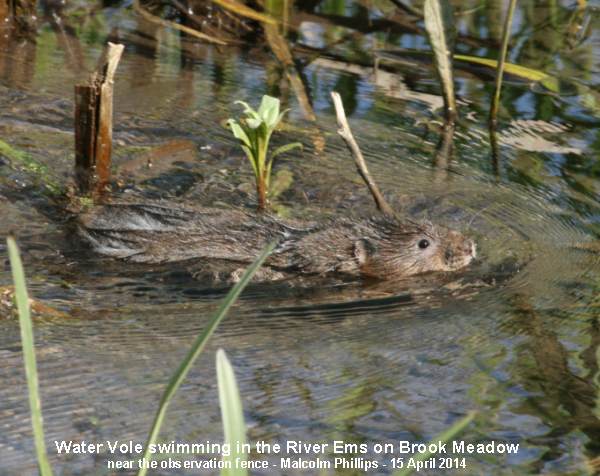
Rob Foord e-mailed to
say he saw two Water Voles tonight at the same spot as
last night, plus and what were probably two rats (more
skittish than the water voles) running along and
around the sluice gates. Fading light made definitive
identification difficult.
Yellow
Dung-fly?
Brian Lawrence
snapped this fly on Brook Meadow today. I have also
been seeing these golden furred flies regularly on
Brook Meadow. I think they are Yellow Dung-flies
(Scathophaga sterocaria).
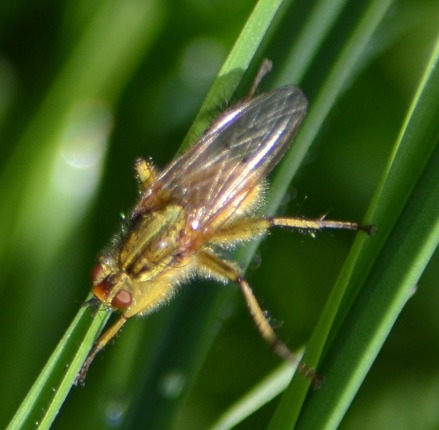
Mystery
Sedge
Martin Rand
has confirmed the identity of the mystery sedge with
exceptionally long bracts that I found on the old NRA
track on North Thorney on April 1st. It was, as I
suspected Divided Sedge - Carex divisa.
It just goes to show how variable plants can be in
different situations. A bit like people, I suppose.
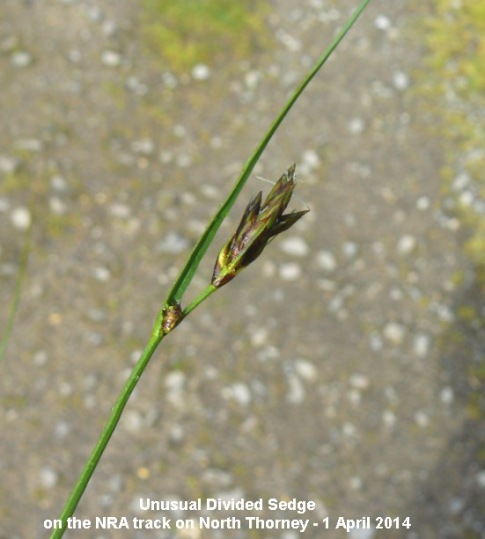
Southbourne
Copse
John Tagg
contacted me about the terrible destruction of the
woodland that is taking place in the area we have
labelled 'Southbourne Copse' (Grid Ref: SU 7565 0612),
situated at the end of Woodfield Park Road. The only
access is from the public footpath from the end of
Penny Lane. There is no access from Woodfield Park
Road.
John knows the area well and back in June 2010, he
alerted me to what looked like a route through the
copse marked with orange spots on trees (to be
felled?). I recall writing to a Mr L Tirebuck at
Southbourne Parish Council for information, but he
knew nothing about it.
Nothing appears to have happened until now when, as
John writes, "suddenly, the whole area has been
barb-wired and woodland cleared and still nobody seems
to know what happening or who is doing it. Half of the
copse has already been cleared as shown in the photo,
including some mature Oak trees.
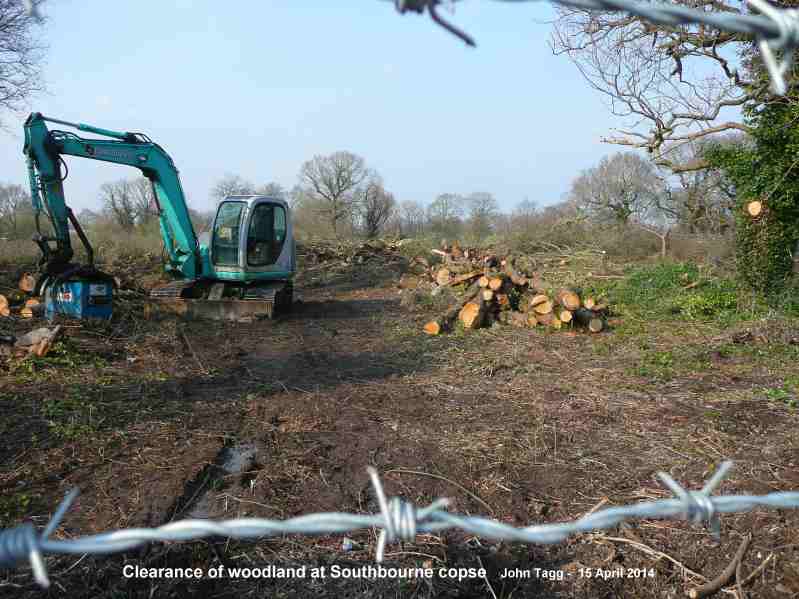
Although work has
stopped in the last week, the digger is still there
awaiting a restart of the clearance. The trains are
now clearly visible from Woodfield Park Road. There
must be some sort of planning in operation, but no
notices have been posted to inform anyone. It is
obviously too late for all the birds, bees, flora and
fauna, as the damage has already been done."
Come on. What the heck is going on? Someone must know.
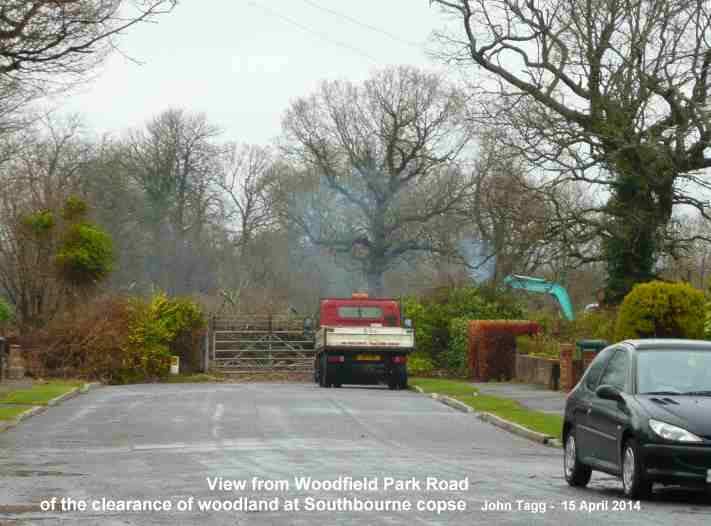
MONDAY
APRIL 14 - 2014
Waysides
News
Jane Brook and
I surveyed three local waysides this afternoon. We
started at the Railway Wayside to the north of
Emsworth Railway Station where we filled 4 HBC bags
with a variety of litter thrown from the new ramp to
the station, plus some hefty bits of electrical
equipment. It is amazing what people throw out. We
have lost part of the original site to the new track
from New Brighton Road to Washington Road. It will be
interesting to see what comes up in this area which
has new soil imported.
From there we looked at the New Brighton Road junction
wayside where we found Hawthorn in flower along
with clumps of Bulbous Buttercups.
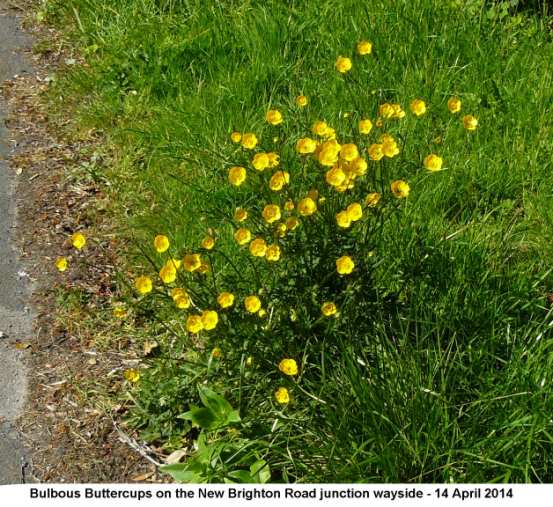
Also, Soft
Brome, False Oat-grass and Smooth
Meadow-grass. Finally we walked along the
Washington Road path where we noted the first leaves
on the rare Greater Burdock (Articium lappa)
which was identified last year.
Flowering plants of interest were Field Forget-me-not,
Meadow Buttercup, Bulbous Buttercup, Oil-seed Rape,
Wintercress (buds not open), Common Vetch, Red Clover,
Thyme-leaved Speedwell, Germander Speedwell,
Cleavers.
Grasses included False Oat-grass, Cocksfoot, Meadow
Foxtail, Soft Brome and Smooth Meadow-grass.
Brook
Meadow
Charlie
Annalls had her maiden walk around Brook Meadow and
was rewarded with some very good wildlife sightings.
She found the butterflies a little skittish and
reluctant to pose for photos, but she did get a
smashing Peacock.
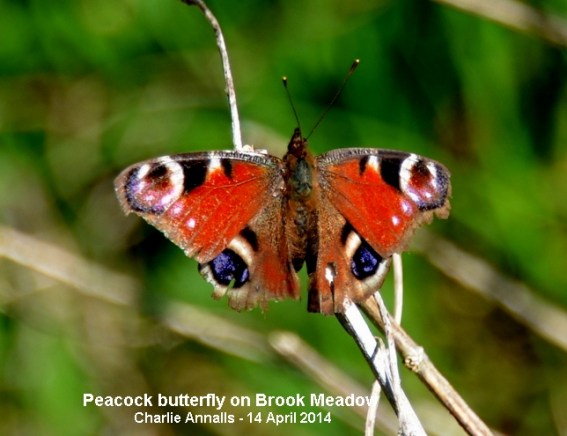
But Charlie's best
sighting by far was a fine male Bullfinch high
in a tree. This was our first Bullfinch on Brook
Meadow this year. She says, "the colour was
outstanding and at first I thought it was a very large
robin!"
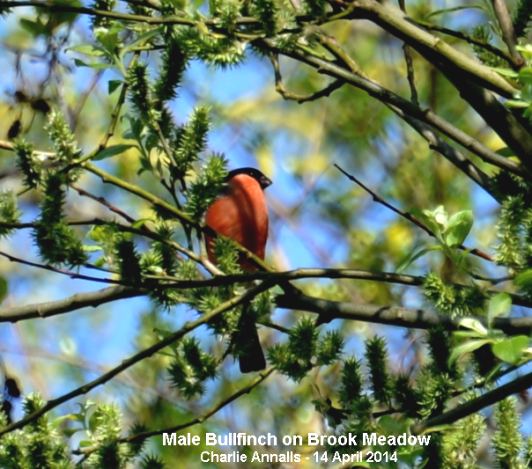
Charlie concluded,
"All in all a lovely afternoon exploring Emsworth and
I loved the meadow. I shall return when its a bit
warmer and hope to find the butterflies in sleepier
mode."
Swan
news
Before she
left Emsworth, Charlie visited the swan nest on the
town millpond and was pleased to see five eggs in it
which she thought looked different colours. Probably
some were a bit dirty? The adult swans were busy
building it up with twigs and other debris.
Langstone
Mill Pond
Peter
Milinets-Raby had a short visit to Langstone Mill Pond
this morning (10am to 11:40am). He walked in via Wade
Lane and the highlights are as follows:
Wade Lane: Female Blackbird with two fledged young,
Mistle Thrush collecting worms, Buzzard perched on
usual tree, Kestrel chasing Carrion Crow, 1 Swallow
north, 3 Meadow Pipits north, Chiffchaff singing.
Mill Pond: Peter's big surprise was finding two
'almost fully grown' Grey Heron chicks in the Holm
Oak. The two youngsters were quite vocal at times, but
the adults did not feed them; they just sat and
preened. When the adults left the nest, the youngsters
were very difficult to pick out. The chick is in the
centre of this photo with white face and grey head.
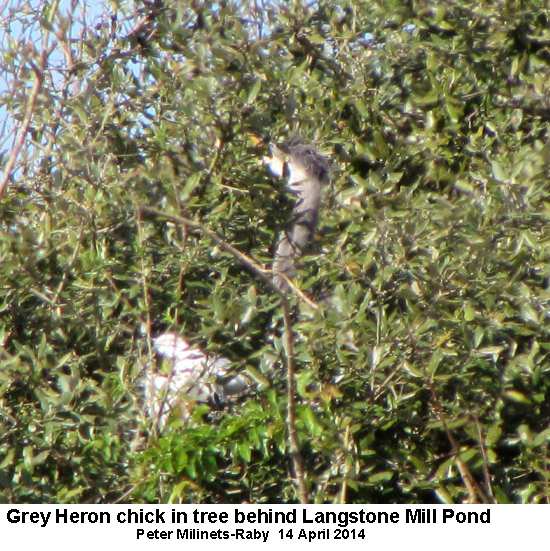
The other Grey Herons
nests were quiet, though the female on the one at the
top of the Holm Oak stood up and carefully arranged
something at her feet before sitting down and out of
sight.
Female Mute Swan still on nest - tended eggs for 2
minutes. Blackcap, Willow Warbler and Chiffchaff all
singing from the back of the pond (no Reed Warblers
yet). And, 2 Swallows over north.
Off shore: (nearly high tide). 2 Sandwich Terns,
Black-tailed Godwit, Female Goosander sleeping with a
male and 2 female Red Breasted Mergansers close to
Pook Lane path.
Mystery
fly
I sent a copy
of the photo of the black fly that Malcolm Phillips
took on Brook Meadow on Apr 8 to Bryan Pinchen. Bryan
said it was an Ichneumon wasp (Hymenoptera;
Parasitica), but as to which species he had no
idea as they are a large and diverse group for which
no useable identification guide exists. Most are
parasitic on larvae of other insects, including moths,
butterflies, beetles, true bugs and flies.
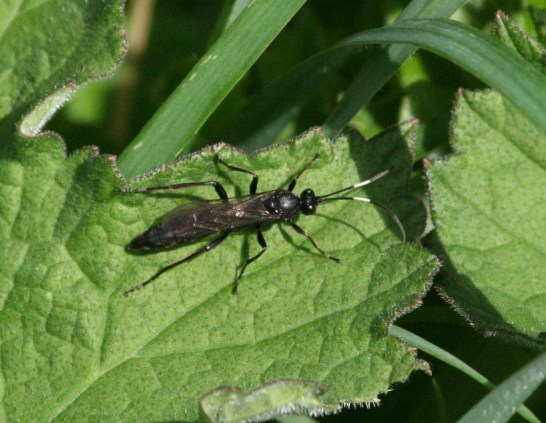
SUNDAY
APRIL 13 - 2014
Water
Vole on Brook Meadow
Francis
Kinsella got an important Water Vole sighting in an
area where none have been previously seen this year -
in section D, on the river bank opposite the
observation fence. This area was badly flooded in
early spring, but it looks as if voles might be moving
back into this area which has very been popular with
them in previous years.
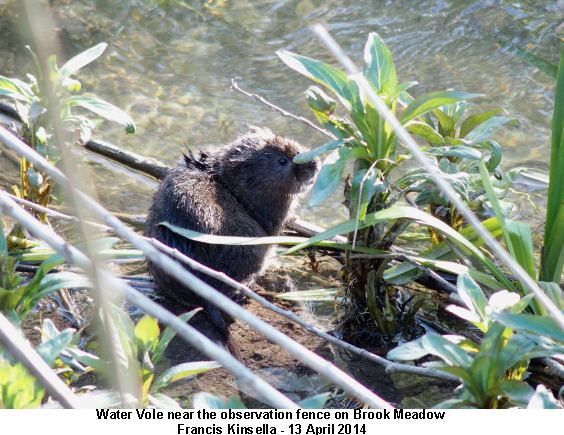
Adders
in Havant Thicket
Having read
about them there for so long, and after several
unsuccessful attempts, John Bogle finally managed to
find some Adders at Havant thicket today! John sent me
photos of a male and a female (the male is grey and
black, the female brown and black).
John adds, "As I was
looking for butterflies I only had a Macro lens on me,
making it a little tricky to get close to them with
very dry and very noisy bracken under foot but the
female obliged at the second attempt! I managed to get
within 6ft or so for this shot. I have found that
reptiles very often return to the same spot if you
leave them alone for a while, and that is exactly what
happened with both of these! I shall for sure be
returning to the area again now!
Butterflies
John said
Orange Tip butterflies were far too active for
any photographs today, but he sent one he found at
roost, also at Havant Thicket, a couple of days ago.
Although only the underwing is showing, which is the
same in both sexes, one can just see a hint of the
orange upper wing tip which identifies this one as a
male.
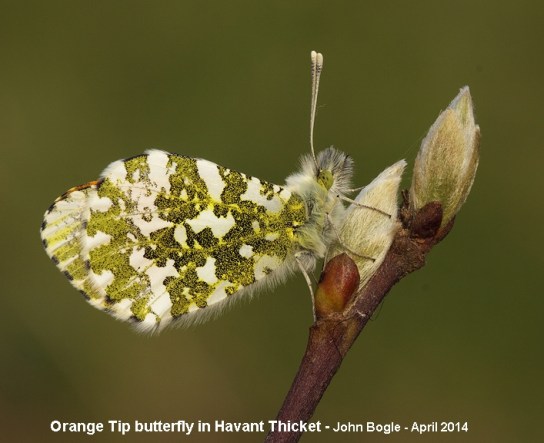
John also had his
first Holly Blue in the garden in Havant. Snap!
We had our first Holly Blue in the garden here in
Emsworth also.
Warblington
Peter
Milinets-Raby was out early for a walk along the
Warblington shore from Conigar Point to the Langstone
Mill Pond (6:50am to 9:05am). The highlights were as
follows (so few migrants around):
Ibis Field: Willow warbler calling and heading north
through the bushes, 3 singing Chiffchaff, Med Gulls
over, 2 male Pheasant, Blackcap singing,
Conigar Point/fields: Skylar singing from high, 2
Linnets, 7 Cormorants over heading east, 8
Shelduck.
Off Pook Lane: Female Goosander on its own diving in
the low tide channel, Sandwich Tern resting on a buoy,
24 Shelduck, 6 Grey Plover and 5 Dunlin over heading
east, 5 Great Black-backed Gulls, 4 Black-tailed
Godwits, A single Whimbrel. Peregrine flew over
heading south to Hayling, disturbing the gulls and
Oystercatchers
Langstone Mill Pond: Reed Bunting male moving about,
but not singing, Single Swallow over north,
Little Egrets - Very quiet with birds sitting and
partners out feeding. Only managed to count 53 Little
Egrets present in total. Grey Herons also quiet. Mute
Swan on her nest still.
Mill stream/channel: Greenshank (ringed/tagged bird,
but only top rings as bird was up to its knees in
water, but almost certainly probably G-R/BtagR). A
single Brent Goose, 3 Red Breasted Merganser, Plus
briefly a Seal popped its head above water before
disappearing.
SATURDAY
APRIL 12 - 2014
Millpond
News
The Mute
Swan nest near the bridge on the town millpond now
has 4 eggs in it. The last one was laid this morning.
The first Coot
family of the year of two adults and 3 chicks was
on Peter Pond this afternoon. Here is one of the
adults feeding a chick.
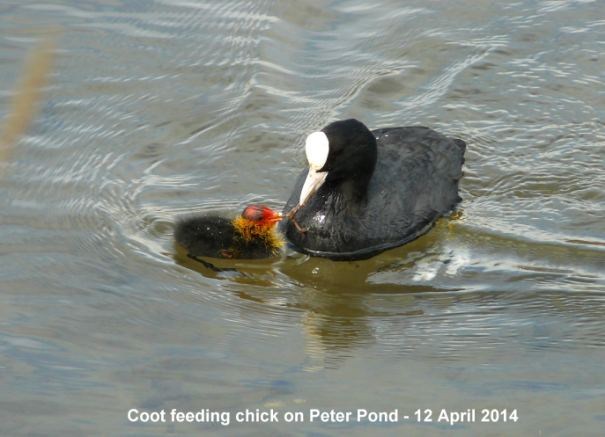
The Mute Swan
was on the nest in the reedbeds on Slipper Millpond
with her mate on the water nearby.
About a dozen
Mediterranean Gulls were on Slipper Millpond
when I passed by this afternoon, including these four
on the wired centre raft. These will probably be
moving over to their breeding colonies in Langstone
Harbour. See Chris Cockburn report below on the
Hayling Oysterbeds update.
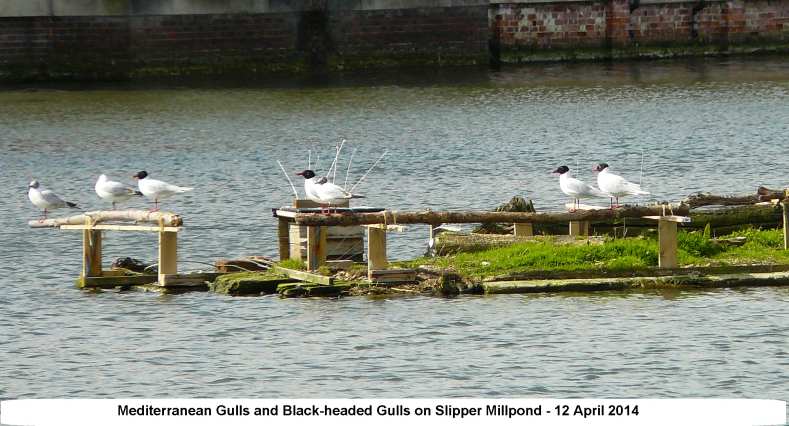
Brook
Meadow
There is a
good crop of Sticky Mouse-ear growing on the
south bridge of Brook Meadow.
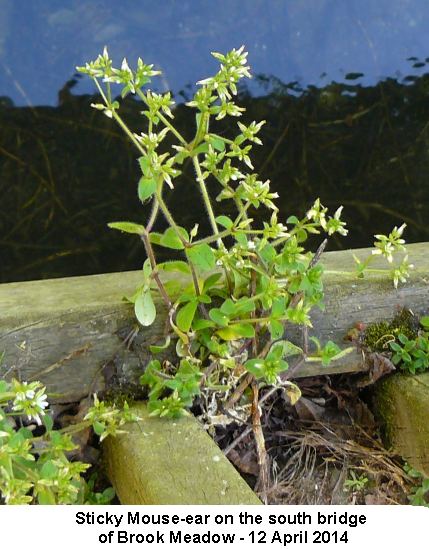
I was surprised to
find that this was a new plant for the Brook Meadow
list, taking the total to 318 species, excluding
casuals and garden escapes. See complete list at . . .
http://www.brook-meadow.hampshire.org.uk/bm-list-plants.html
Tony Browne saw a
Slow-worm on the causeway path 25 yds west of
the Lumley gate. It was approx. 12" long and thickish
pencil girth, Fine bronze (& black) scales. Tony
was concerned about it getting trodden on by a human
or eaten by a dog, so he coaxed it back into the
grass.
Pagham
Harbour
Heather Mills
reported on this morning's walk by the Havant Wildlife
Group, including a good view of a Cuckoo. For the full
report go to . . . http://familyfellows.com/hwg-walk-reports-2014.htm
Hayling
Oysterbeds news update
Chris Cockburn
reported:
"The black-headed gulls finally recovered from
yesterday's attack by a child's blue balloon and are
now really getting down to nest building. It is likely
that many nests will need rebuilding if the upcoming
spring tides start surging. However, the predicted
astronomical tides for April, May and even June are
not particularly high, so fingers crossed for lots of
high pressure systems.
The recently imported shingle on the east end of the
"NW Bund" looks very promising and hopefully, common
terns, little terns, oystercatchers and ringed plovers
will find it attractive as a nesting site.
The Mediterranean gulls are not nest building
on the lagoon islands yet; but they are later nesters
anyway. Today there were at least seven 1st summer
Meds in the lagoon. Non-breeding Ist summer Meds are
not the ideal birds to have in a gull and tern colony
- given half the chance, these troublemaking
delinquents will readily predate eggs & chicks -
even of their own species.
Up to now, this year, South Binness and Round Nap
Islands have rarely had gulls on them - but when they
do, there are very many birds holding territory. There
has been some peregrine (male & female) activity
on the harbour's islands (roosting & feeding) and
that, unsurprisingly, may deter the seabirds from
nesting or even sitting on the islands! This has
happened in previous years and the problem was solved
by increasing the frequency of close-to-island
boat-patrols that encouraged peregrines to use Long
Island and North Binness Island (islands not used for
nesting by seabirds).
Apart from a few swallows flying past, there has been
no significant migrant activity at the site; but the
weather has often been good for birds to continue
flying inland.
For the past week or so, one of my favourite spring
events has been taking place - curlews leaving the
harbour on their way to nesting grounds - even above
the black-headed gull "din", there is the sound of
calling curlews as they climb higher and head off
eastwards - great! Interestingly, a blackbird that has
territory opposite my flat has incorporated some of
the curlew sounds -making me rush to the balcony to
scan the skies!!
Insects are more in evidence - several "Whites" that I
have not yet identified (they would not cooperate by
stopping still for a few seconds, Small Tortoiseshells
egg-laying on nettles etc.
The wet winter has resulted in the vigorous growth of
Medick plants (as in 2012) and there are many Milk
Thistle rosettes (just 3 in 2013!) - Lesser Celandines
and Daisies are currently in profuse bloom - it is all
looking good!
FRIDAY
APRIL 11 - 2014
Mute
Swan named
This morning I
met Tony Wootton near the bridge at the top of the
town millpond. Tony asked me if I knew the Christian
name of the swan, which I did not. He then pointed out
a label which the swan had collected during the nest
building marked 'Fleur' . We both recalled that was
the name of the character played by Susan Hampshire in
the long-running BBC drama 'The Forsythe Saga'.
Hollybank
Woods
I had a very
pleasant walk through Hollybank Woods this morning
with birds singing all around and wild flowers
starting to show.
I heard most of the common woodland birds, including
Song Thrush, Blackbird, Robin, Dunnock, Wren, Great
Tit, Blue Tit, Great Spotted Woodpecker drumming,
Nuthatch, Jay, Carrion Crow, Woodpigeon and Stock
Dove. In addition, several Blackcaps and Chiffchaffs
were singing, but I did not hear any Willow Warbler
which I sometimes get in the woods.
Flowering plants that caught my eye included Cherry
Laurel on the track from the top of Hollybank Lane and
Yellow Archangel (ssp. argentatum) with the white
blotched leaves near the southern entrance gate.
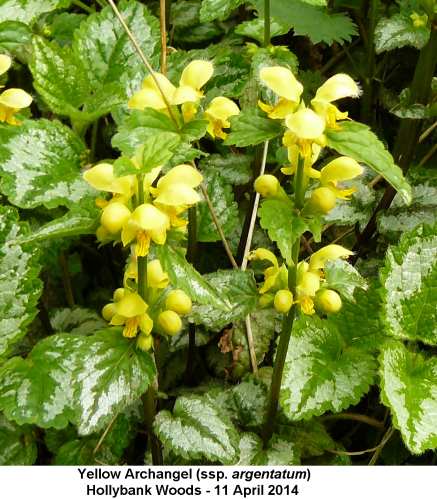
Field Wood-rush,
Barren Strawberry, Common Dog-violet, Common
Stork's-bill, Wood Speedwell and Crosswort were all
out on the Holly Lodge clearing (south). Also, Wavy
Bitter-cress with a distinctly wavy stem and 6 stamens
in the flowers.
The Lily of the
Valley plants are now in bud in the open area
north of the Holly Lodge clearing. The two main areas
of Bluebells on the eastern section of the
woods are starting to open, but will not be at their
best for a week or two. The Wild Cherry tree in
the southern Bluebell area is in full blossom and
looking magnificent.
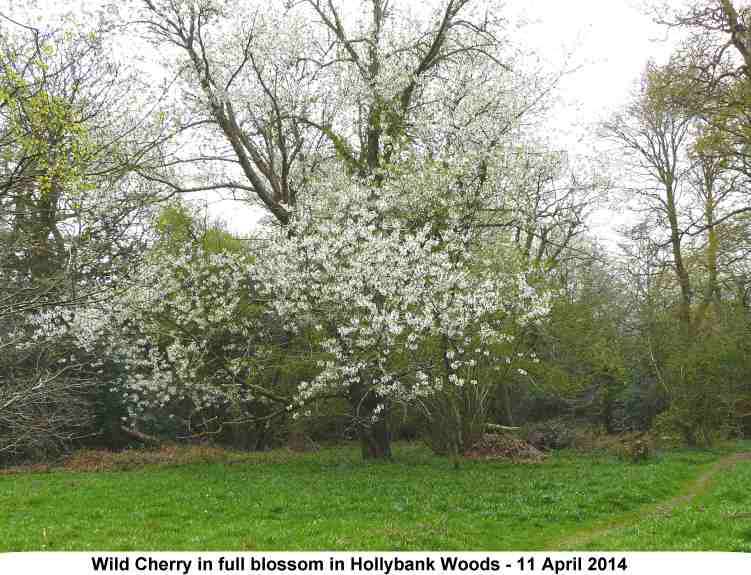
I noted several
Bumblebees including this ginger fellow on a
Dandelion, presumably Bombus
pascuorum.
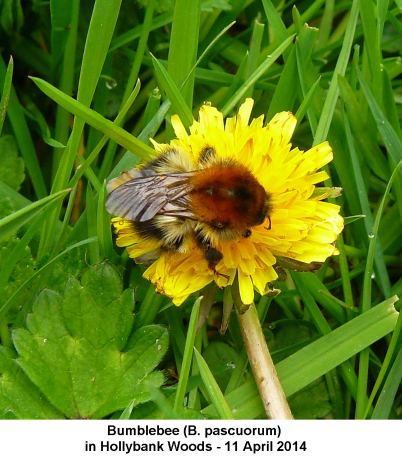
I met up with Andy
Brook and his young apprentice whom Andy is grooming
to take over the leadership of the woodland activities
in the near future.
Chichester
walls
Chris Oakley
and his wife Ann took a walk around the Chichester
walls this morning. The banks below the walls were
full of colour from Red Campion, Alkanet, Bluebells,
Primroses. Cowslips and even a few Fritillary with
their curious chequered markings. In Priory park, this
Squirrel spent ages scratching around before finding
his hidden treasure.
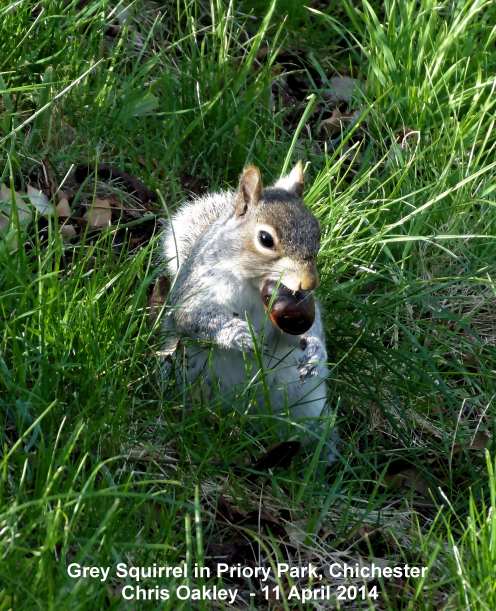
THURSDAY
APRIL 10 - 2014
Unusual
Blackbird song
A Blackbird
has been singing a very unusual song from a
neighbour's garden for the past week or so. The song
is short and whistled with a thrush-like repetition
but is certainly not a Song Thrush.
Mute
Swan news
The swan's
nest beneath the bridge on the town millpond now has
three eggs in it; the third one must have been laid
this morning as there were only two yesterday. Mute
Swans lay an egg every other day up to 6-8, so we are
likely to see a few more before incubation starts.
Wayside
flowers
I found the
first False Oat-grass of the year in flower on the
A259 embankment outside the Emsworth Surgery. Japanese
Knotweed is coming through again on this wayside and
on the path behind Lillywhite's Garage.
Bee-fly
on Cuckooflower
I watched a
Bee-fly (Bombylius major) feeding on the
Cuckooflowers on the Bridge Road Wayside. It moved
from one plant to the next, hovering in front of the
flowers and sucking up nectar though its long
proboscis.
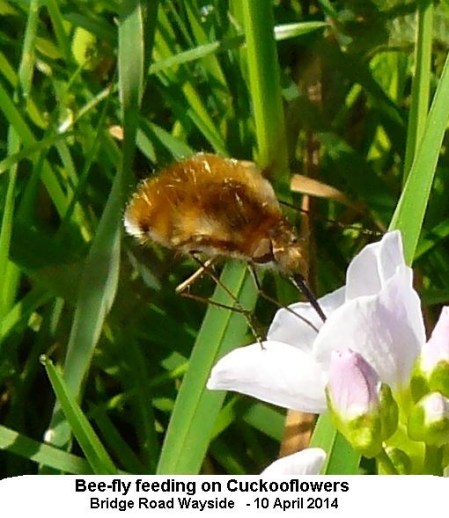
More
Lizards on Brook Meadow
Malcolm
Phillips showed me the reptile mats on the north
meadow where he found the Lizards yesterday. They were
there again today, two were on top of one mat and one
on another. We did not look beneath the mats. The
Lizards were clearly seeking the warmth of the dark
mats.
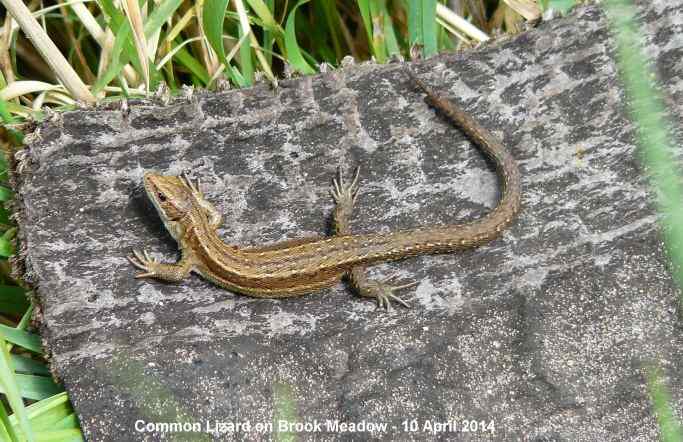
Butterflies
Plenty of
butterflies were out on the meadow, including Peacock
(lots), Small Tortoiseshell, Orange Tip and Small
White. Both Malcolm and Brian Lawrence got photos of
Holly Blue - the first on Brook Meadow.
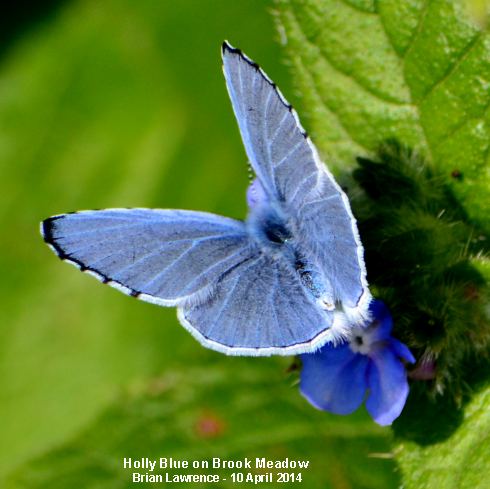
Brian also saw a
Speckled Wood which takes the number of butterfly
species recorded on Brook Meadow so far this year to
nine.
Water
Voles
As I was
walking up the main river path on Brook Meadow, I
noticed a patch of cloudy water on the west side of
the river just beneath the large Bay tree in front of
the old gasholder. The cloudiness appeared to be
coming from a disturbance of the mud on the river
bank; it kept coming and going as the flow of water
dispersed it.
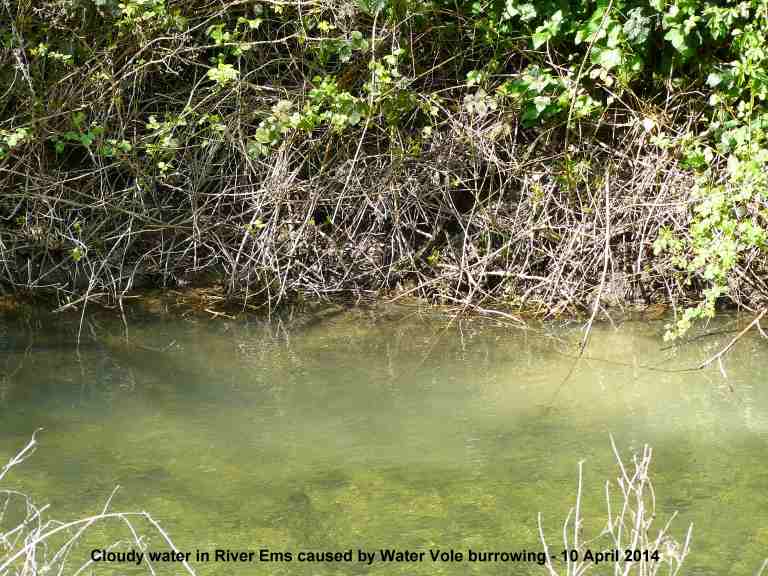
Malcolm Phillips
arrived and we both looked closely at the bank for
some minutes until Malcolm spotted a Water Vole. We
continued to watch the river bank and got several
fleeting glimpses of the Water Vole as it scuttled
from a burrow hole in the river bank to the left of
the cloudy area and into the river to continue its
digging below the water level.
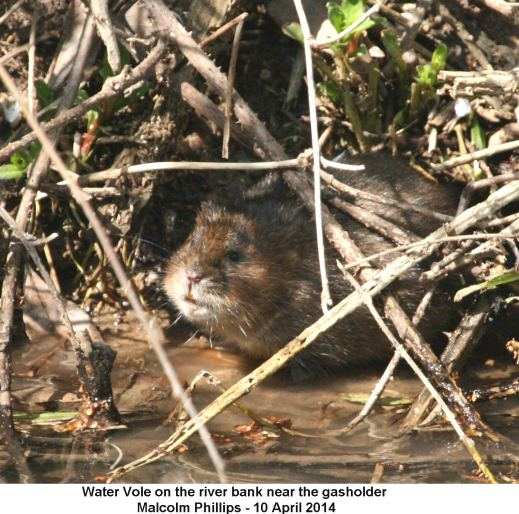
This clearly was the
source of the cloudiness. This was Malcolm's first
Water Vole sighting for 3 weeks and my first one of
the year!
After he left me Malcolm saw another Water Vole on the
north river right where he saw the Weasel yesterday.
This is particularly good news as it probably means
that they can live together! Here is the vole having a
swim.
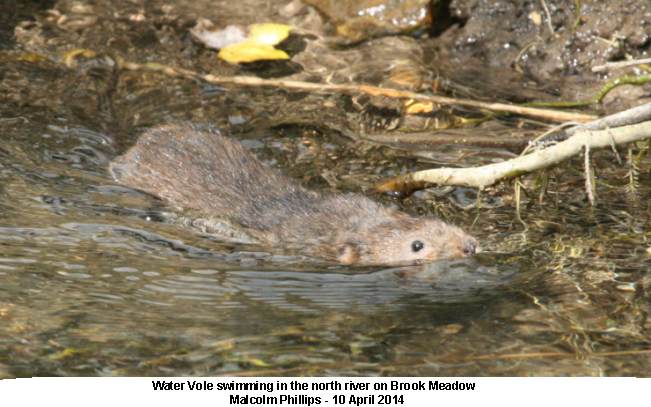
Horndean
Down
Peter
Milinets-Raby went for a circular walk around Horndean
Down this morning (10:25am to 12:45pm). New Barn Farm
Lane - East edge to the Windmill, then back along the
western edge. The birding highlights were as
follows:
Pair of Ravens (again) nesting on the pylon as
last year. The young (certainly two, probably three)
are fairly young still.
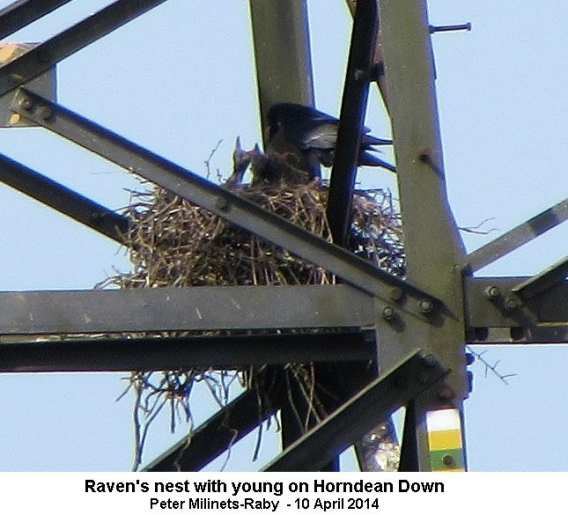
Peregrine soaring
around, before landing on one of the pylons. 5+
Buzzard soaring around with lots of tumbling display,
plus they received lots of agro from the Ravens who
often chased them around. Sparrowhawk. 1 Willow
Warbler singing, 3+ Chiffchaff singing, 4+ Blackcap
singing, 1 Swallow seen moving north, 1 Meadow Pipit
moving north, 2 to 5 Yellowhammer, pair of Stonechat,
2 to 4 Linnets, 3 Wheatears, 8+ Skylarks, Male
Pheasant.
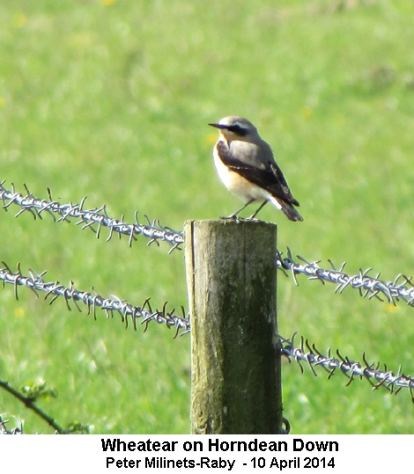
Chinese
Geese at West Ashling
Ralph Hollins
identified the 'geese with beautiful blue eyes' that
Peter Milinets-Raby found on West Ashling pond on
Tuesday 8th April as Chinese Geese.
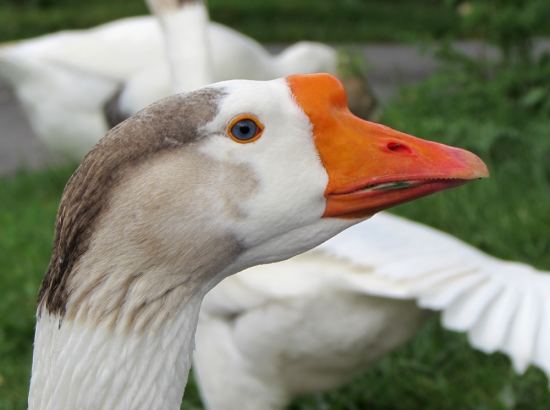
Chinese geese come in
two colour forms: the white and the brown (also called
'grey' or 'fawn'). The brown is the same colour as the
brown African. Both breeds come from China, and were
developed from the wild swan goose. Peter's photo
presumably shows the brown form of goose. See . . .
http://www.waterfowl.org.uk/keeping-geese.html
These geese have been
resident on the pond for many years, at least since
September 2008 when I took this photo.
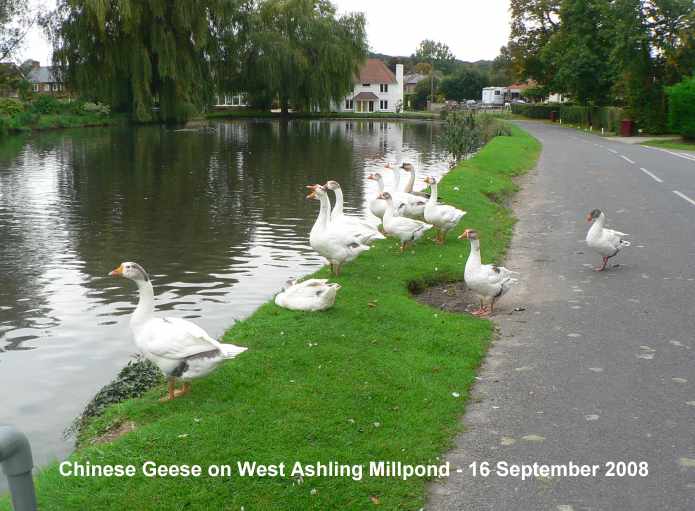
Interestingly, the new
BTO web site with Atlas Maps shows a scanty
distribution of Chinese Geese, but no record as far as
I could judge from the map in West Ashling. Maybe they
are not regarded as 'wild'.
See . . . http://blx1.bto.org/mapstore/StoreServlet
Dry
summer?
Chris Oakley
observed from the leaves on the trees outside his
North Emsworth house that we are probably in for a dry
summer if the old adage is to be believed. 'Oak before
Ash then we get a splash. Ash before Oak then we'll
get a soak'.
WEDNESDAY
APRIL 9 - 2014
Nore
Barn
This morning I
cycled to Nore Barn where the tide was falling.
Nothing in the stream. The pure white flowers of
English Scurvygrass are now showing very well
on the saltmarshes to the west of the stream. This is
the best flowering of English Scurvygrass that I have
ever seen at this site. Blackcap was singing in the
woods.
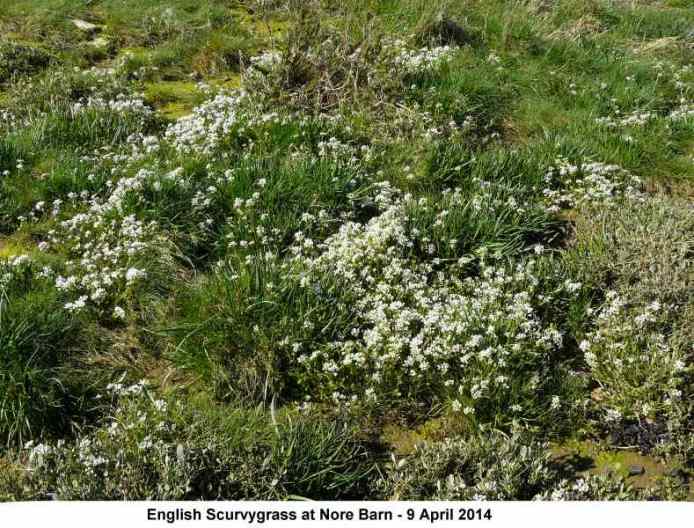
Millpond
News
On Emsworth
Millpond the swan nest near the bridge was just above
water level with two eggs showing and the pen swan
nearby.
All quiet on Slipper Millpond where the Mute Swan pair
was on the water. I could see one egg in the nest in
the reedbeds, so they have made a start! The pen will
lay all her brood before she starts to incubate them
and hatching will be 36 days from then.
Marina
seawall
The well cut leaves of Hemlock were clearly
visible on the marina seawall but no flowers as yet.
Cow Parsley was in flower. There were plenty of
Ladybirds on the nettle leaves, some 7-spots
and some smaller ones with variable spots which may be
varieties of 2-spot.
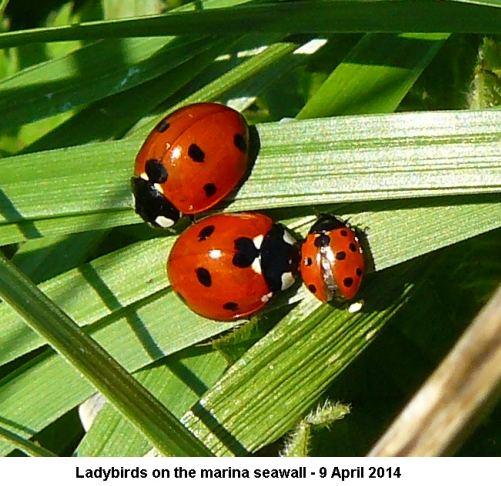
I could see a
geotagged Greenshank feeding on the shore by
the marina seawall, but with only my binoculars I
could not clearly see the rings. I took some photos
which seemed to show G//R+BL though I am not entirely
sure of the lime ring. Information to Anne de Potier.
North
Thorney
One Canada
Goose was on the Deckhouses Estate pond. I walked down
the track to Little Deeps, but there was no sound of
Sedge Warbler which arrives before Reed Warbler.
Similarly there was nothing of special interest along
the old NRA track apart from the explosive songs of
several unseen Cetti's Warblers. Still no Swallows,
though I met Barry Collins later who told me he had
seen two Swallows flying around the sewage
works in Thornham Lane. There was a buttercup flower
by the side of the track with the distinctive reflexed
sepals of Bulbous Buttercup - my first of the
year.
Brook
Meadow
Malcolm
Phillips had a very interesting day on Brook Meadow.
Most significant was a sighting of a Weasel on
the north bank half way between the willow and the
tunnel under the railway - the first on Brook Meadow
since 2011. Malcolm wonders if this could explain why
we are not getting many Water Vole sightings. I am not
sure how serious Weasels are as predators of Water
Voles, but their presence could be critical,
particularly with numbers of voles currently low
following the flooding.
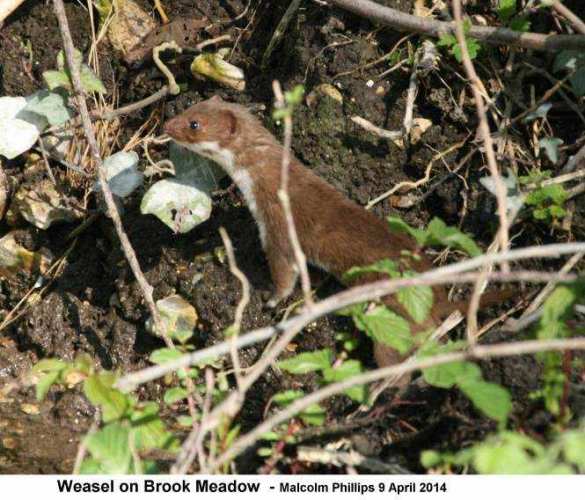
Malcolm also saw three
Common Lizards on the meadow today, which is
interesting in view of the reptile survey which is
currently underway by Azure Ecology. The Lizards were
on two of the mats at the north end of the meadow, not
beneath them!
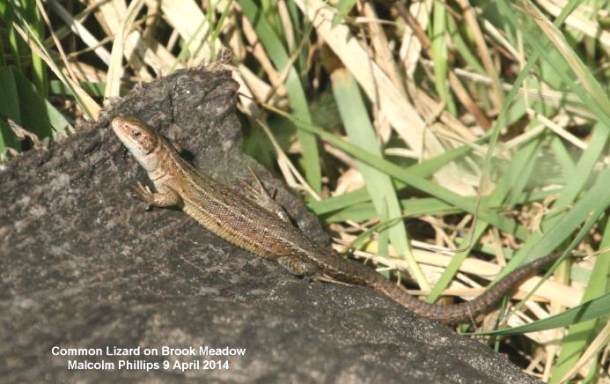
One of Lizards
photographed by Malcolm was minus a tail.
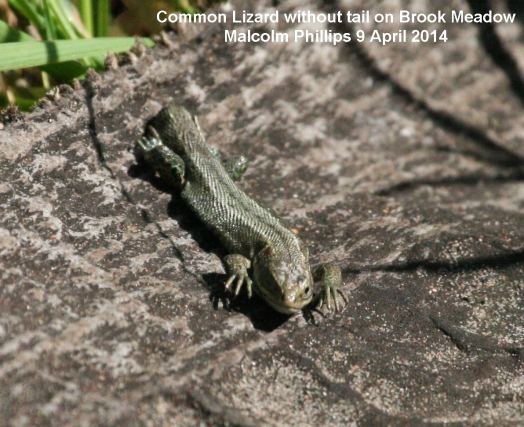
Lizards have evolved
what is called 'tail autotomy' as an escape strategy
when they are threatened by a predator. The predator
is distracted by the tail which may carry on moving
when the Lizard itself remains still. The tail will
regrow in time rather like human tissue and skin grow
when damaged. Tail loss is costly as it represents a
loss of fat and protein, both that stored in the tail
and that which is needed for the regrowth of a new
tail. During this time, young lizards especially are
at higher risk for being preyed upon (there may be
little or nothing else to drop). During the recovery
period, they stop growing. If it happens to an adult,
their reproductive life goes on hold.
Langstone
Mill Pond
After work
today Peter Milinets-Raby called in on the Langstone
Mill Pond (3:30pm to 5:05pm). The birding highlights
were as follows:
Offshore along the low tide mud edge: 9 summer
plumaged Black-tailed Godwits (coloured ringed BY-/R
tag - could not work out the colour of the ring the
tag was attached too, looked plain like metal?). 2
Brent Geese, 12 Shelduck, 14 Grey Plover (winter
plumage), 5 summer plumaged Dunlin, 2 to 6 Med
Gulls.
In and over the channel: 2 Common Tern, 1 Sandwich
Tern, Female Goosander fishing on its own, 9 Red
Breasted Merganser (8 females with one lucky
displaying male).
On the pond: Water Rail running around by the Mute
Swan's nest and seen on and off.
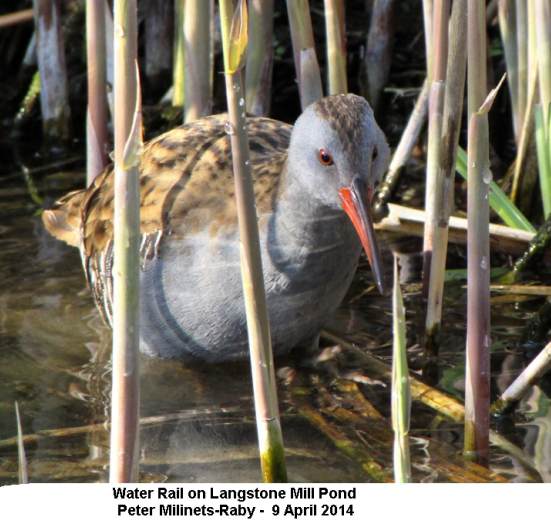
Female Mute Swan stood
up to arrange eggs (still seven on view). Grey Herons
- firmly sat on nests - no action.
Little Egrets:- Before the leaves on the trees obscure
things too much I counted the obvious birds sitting on
nests. On the island - 12 sitting birds (one was
standing up allowing me to see an egg). Grey Heron
trees - 8 minimum, but two others possible: very hard
to count in this area. Elsewhere (along the west edge
of the pond) - 4 sitting birds. So the total at the
moment is 24 definite pairs with two possible
extras.
Horse Paddock just north of pond; Singing Chiffchaff,
4 Moorhen.
Tony's
photos
Tony Wootton sent me some photos from a magical day
walking out a walk with Hilary, near Bishops Waltham.
Here are sparring pheasants and mating orange tips
plus Mallard ducklings from last week at
Arundel.
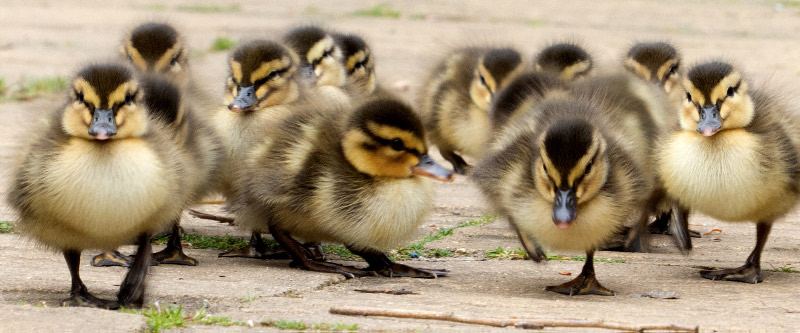
Bullfinches
in garden
Patrick Murphy
has a male - female pair of Bullfinches as regular
visitors to his garden feeders, coming 3 or 4 times
per day.
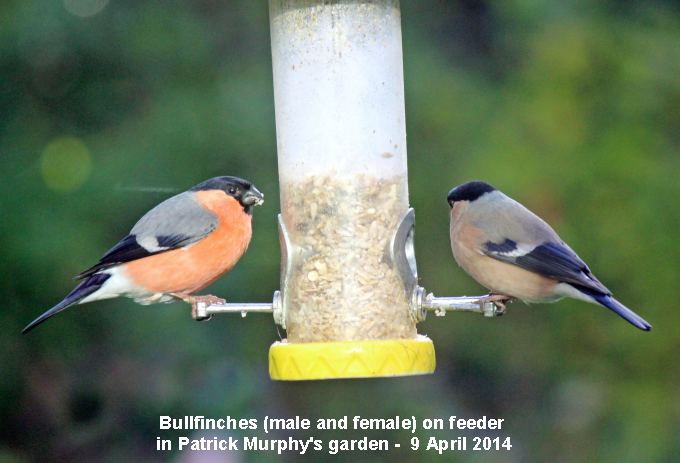
TUESDAY
APRIL 8 - 2014
Emsworth
Millpond
Both Mute
Swans were tending to their nest near the bridge on
the town millpond this morning. It was just above the
water level but looked very wet. There were two eggs
in the nest (one more than yesterday) and one egg in
the water nearby.
Brook
Meadow
I snapped this
ginger Bumblebee feeding on the White
Dead-nettle flowers along the north path - probably
Bombus pascuorum which is the most common ginger
Bumblebee in the country.
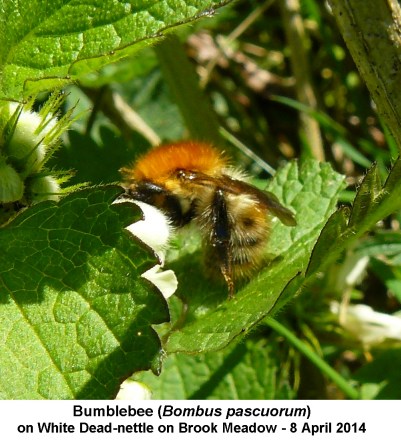
I noted the following
newly flowering plants: Cleavers, Three-cornered
Garlic and Creeping Buttercup )in Palmer's Road
Copse). This was the earliest Creeping Buttercup
recorded on Brook Meadow since 2005.
Small
Tortoiseshells
As I was
chatting with Robin Pottinger on the main river path
we watched a Small Tortoiseshell flutter past and
settle on some vegetation. I saw another one a little
later as it settled on the gravel path in front of me.
It is so good to see them back again after several
years of scarcity.
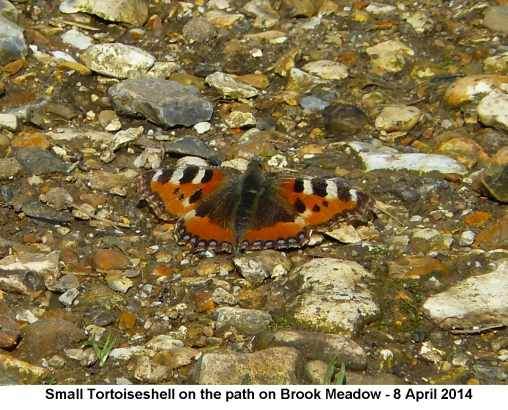
Robin and I got to
talking about the very rare Large Tortoiseshell
butterfly which is now thought to be extinct as a
breeding species. Robin was surprised to hear that I
actually saw and photographed one sunning itself on
the trunk of a tree outside the One Stop shop in
Warblington on 30 March 2012. The sighting was
recorded by Hampshire Butterfly Conservation. This was
my best ever butterfly sighting!
Here
is my photo of the Large Tortoiseshell at
Warblington
showing the extra dark spots on the forewings which
distinguishes it from the Small Tortoiseshell
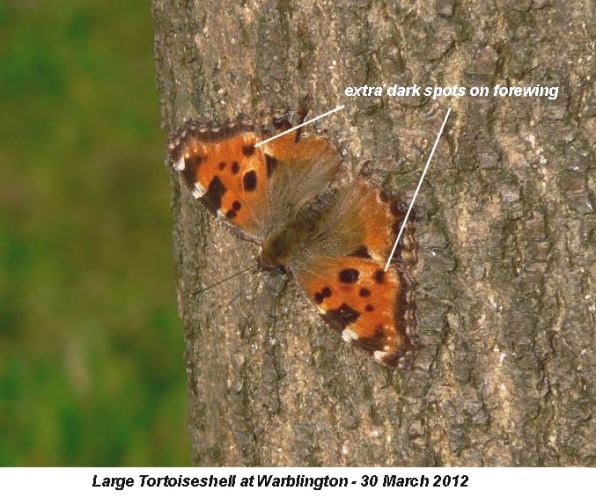
Malcolm's
news
Malcolm
Phillips spent about 2 hours round the meadow this
morning and spent half of the time removing some of
the large logs from the river that were trapped by the
old gasholder. These have come from the north-east
corner where they were thrown into the river by the
local lads. After this good work, Malcolm set out his
camera out to get excellent photos of Orange Tip and
Small White butterflies.
I could not resist
including Malcolm's photo of this beautiful male
Chaffinch which is featured so rarely in this blog.
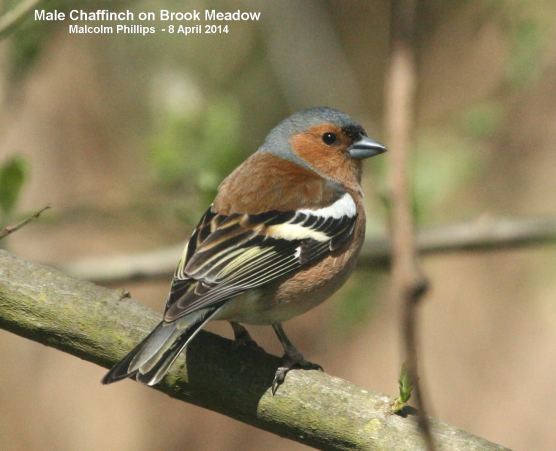
Mystery
Fly
Malcolm also
got this photo of a black fly, which Robin and I also
saw when we were chatting earlier. I thought it looked
rather like a St Mark's Fly though they are not due
until later in the month (April 25th is St Mark's
Day). However, the one in Malcolm's photo is clearly
not a St Mark's Fly due to its long antennae. Ralph
Hollins says it is a Sawfly, but we have yet top
determine what species.

Common
Morel fungus
Chris Oakley
sent me this photo of a strange looking fungus that
appeared in his North Emsworth garden.
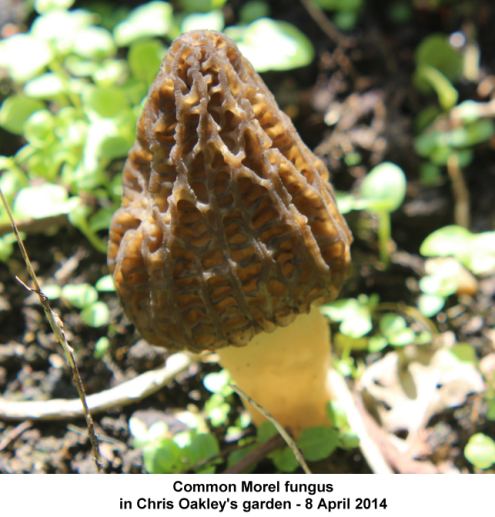
Chris pinned it down
to a Morel, most likely Common Morel (Morchella
esculenta) which mainly grows on woodland edges near
broadleaves trees, but is also common in gardens. This
is not a fungus we see often, mainly due to its very
short fruiting season from April to May. However, it
is highly distinctive with its deeply honeycombed
conical-shaped cap. According to my book it has 'a
wonderful flavour and texture', but take care as there
are similar fungi which are very toxic.
Hedgehog
Last night,
Chris Oakley set up his night sensor camera trap in
the garden and baited the area with some sultanas.
This hedgehog arrived just after 10pm and stayed
around until nearly 5am.
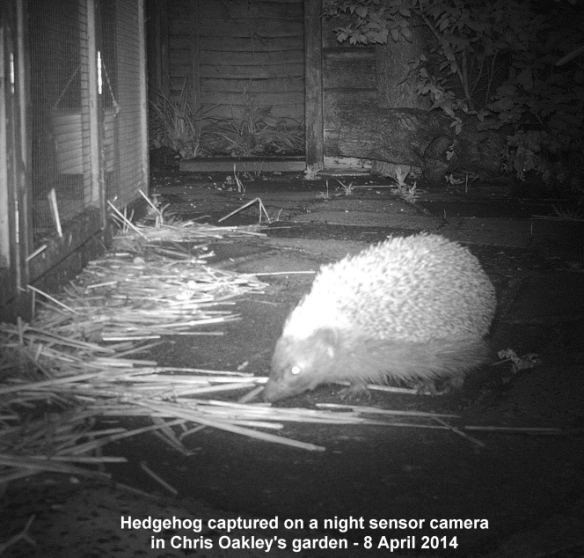
West
Ashling pond
Peter
Milinets-Raby went over to West Ashling this morning.
On his way through Emsworth he observed an Osprey
circling over the pony paddocks south of the main
A259 Havant Road for three minutes before it flew
purposely north over Record Road. When he got to the
pond he found a single Black Swan. There are
usually a few more on the pond where they have nested
in the past.
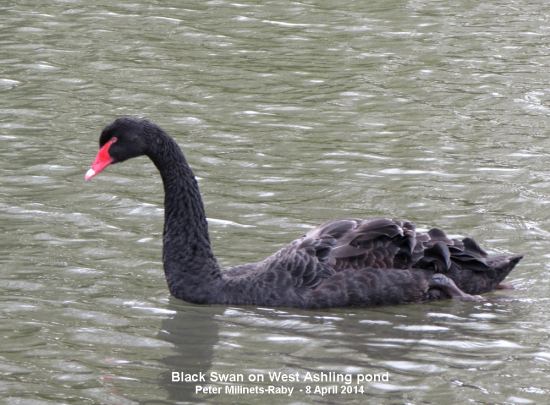
Peter also noted 12
geese with beautiful blue eyes! Ralph Hollins
subsequently identified them as Chinese
Geese.

Chinese geese come in
two colour forms: the white and the brown (also called
'grey' or 'fawn'). The brown is the same colour as the
brown African. Both breeds come from China, and were
developed from the wild swan goose. Peter's photo
presumably shows the brown form of goose. See . . .
http://www.waterfowl.org.uk/keeping-geese.html
. These geese have been resident on the pond at least
since September 2008 - see update on April 10
entry.
SUNDAY
APRIL 6 - 2014
Brook
Meadow
I went over to
Brook Meadow for the regular work session, but it had
been cancelled due to the very wet conditions.
Walking round I noted a Crack Willow tree was down,
roots and all, in Palmer's Road Copse just missing the
nice clump of Summer Snowflake and the newly planted
Alder saplings. The newly cleared area in the
north-east corner of Palmer's Road Car Park badly
needs a litter pick. Pendulous Sedge was in
full flower along the path through Palmer's Road
Copse.
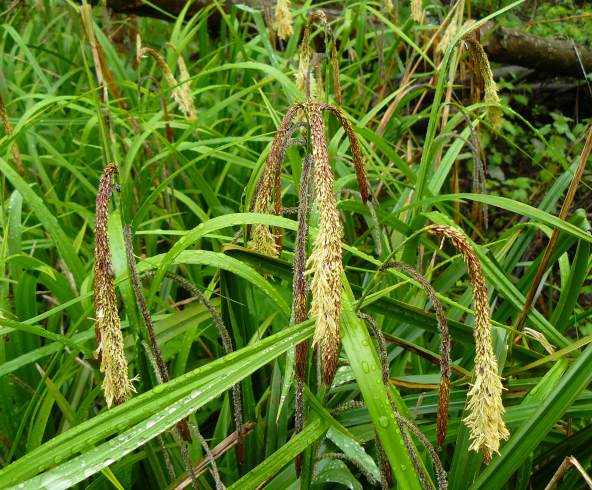
Mute
Swan news
The pair of
swans were both busy building up their nest near the
bridge on the town millpond this morning. One egg and
a plastic plant pot are visible in the nest. It had
two eggs when I last checked on Mar 31. Maybe this one
is a new one?
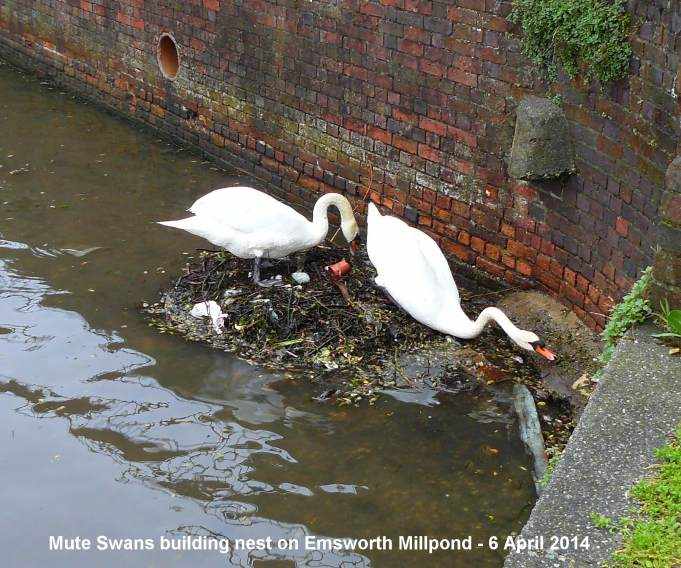
I must admit I had
given up on them a couple of days ago when the nest
had completely disappeared under the water. However,
today, the nest constructed mostly of twigs with bits
and pieces of rubbish, was above the water level..
Much as last year, the nest is becoming an attraction
to people passing by.
Over on Slipper Millpond the swan was settled on her
nest in the reedbeds on the eastern side of the pond
with her mate on the water nearby. This looks
promising.
Waysides
flowers
I did a
recount of the Cuckooflowers on the Bridge Road
car park verge and got to 466. We are approaching the
record of 694 set in April 2012.
I checked the flowers
along the Dolphin Creek wayside. I found my first
example of Lords and Ladies with spathes open
to reveal the spadix.
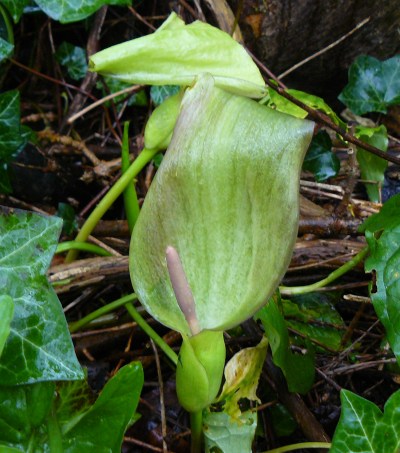
I also found Thale
Cress in flower near the back entrance to Holmwood
House. This photo was taken against the white garage
door of Wharf House to show the structure of the plant
- having a rosette of basal leaves, erect stem with
tiny white flowers.
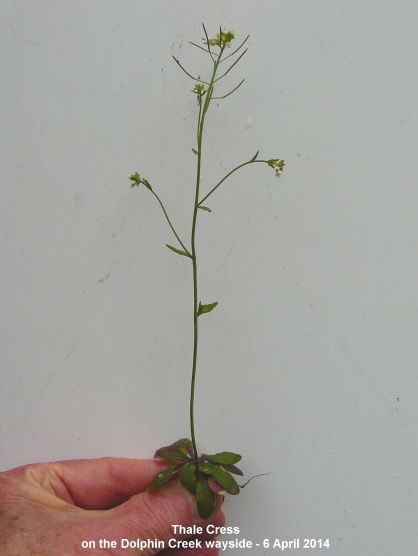
Bosham
Harbour
Jean and I had
a stroll round part of the harbour this afternoon. I
spotted a good flowering of English Scurvygrass
on the saltmarshes on the eastern side of the harbour.
Most of the Hoary Cress was in bud, but I
managed to find a few plants in full flower for the
first time.
The photo shows
English Scurvygrass (left) and Hoary Cress
(right).
We discovered one
Hawthorn bush which was full of blossom - the first
May blossom of the year on April 6th.
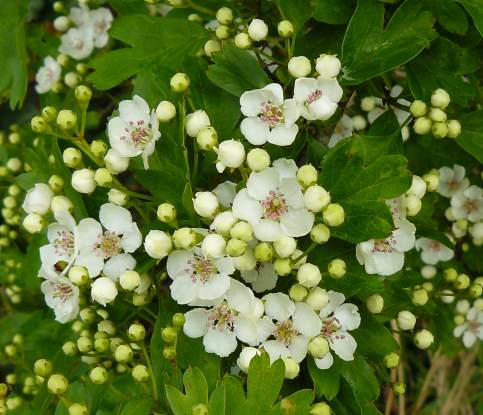
Ashling
Wood - Bluebells
On the way
home, we called in at Ashling Wood where the Bluebells
were in full flower along with lots of Wood Anemone
and Dog's Mercury. The new fencing does not obscure
the view of one of nature's glories. Well worth an
early visit. Take the road from East Ashling to West
Stoke and pull in to the side of the road just past
the small wobbly stile on the left which leads to a
footpath through the Bluebell wood.
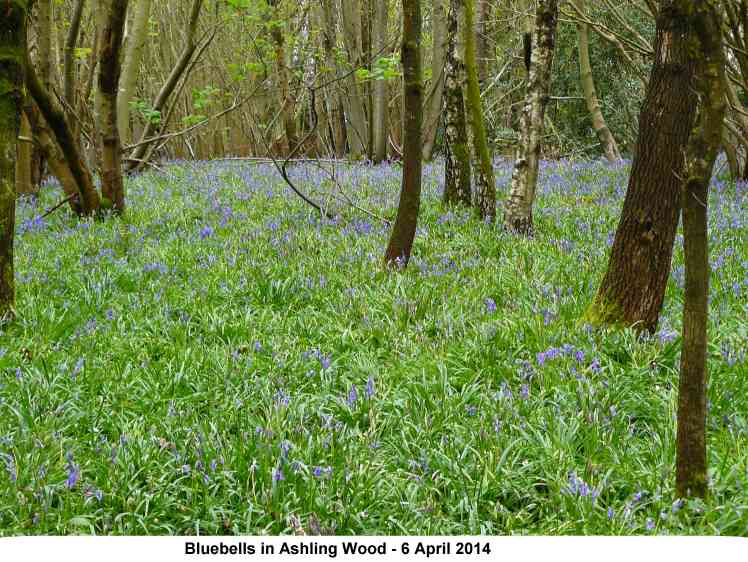
Other
news
Tony Wootton
had what I think was the first Early Purple
Orchid of the year in West Dean woods this
morning.
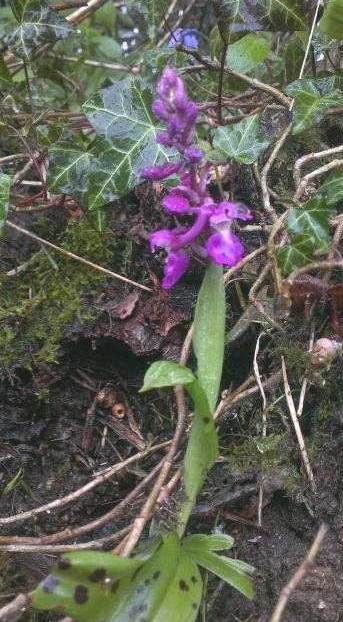
Tony also found a
Magpie Inkcap fungus in West Dean Woods. He
thinks it is out of season as it should be Autumn. It
was growing in a bare patch of land apparently
recently cleared of a log pile, so maybe it was the
introduction of rain and light that made it burst into
life.
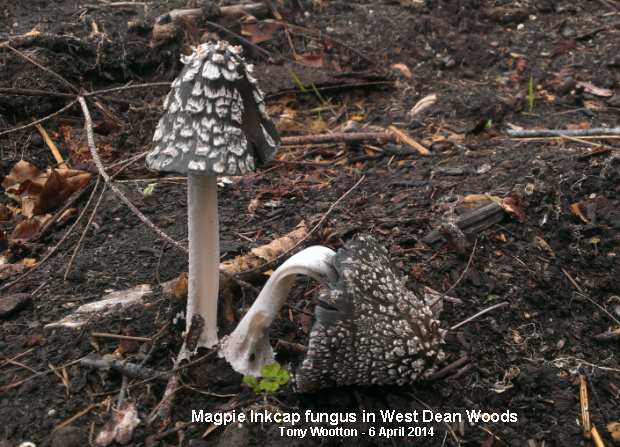
Male and female
Bullfinches are now regular visitors to the
feeders in Patrick Murphy's North Emsworth garden
where they have to share the food with other species,
such as this Blue Tit.
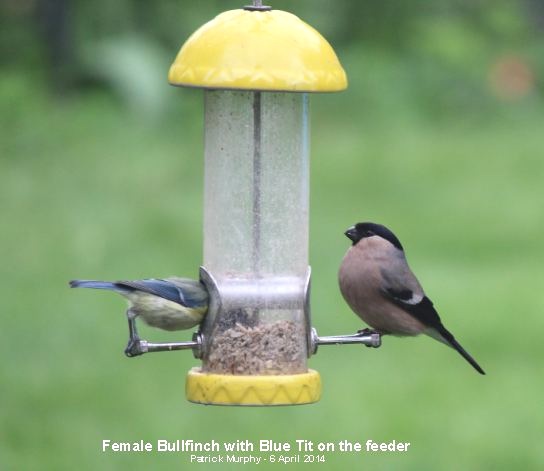
SATURDAY
APRIL 5 - 2014
Brook
Meadow
I had a walk
through Brook Meadow this morning and was pleased to
see the Cow Parsley starting to open its white
flowers along the main river path. Soon we shall be
able to experience walking through an avenue of
aromatic lace flowers when they are fully out. Cones
of Field Horsetail are now up on the north
meadow. The large leaves of Water Dock are
standing tall and fresh on the bank of the Lumley
Stream.
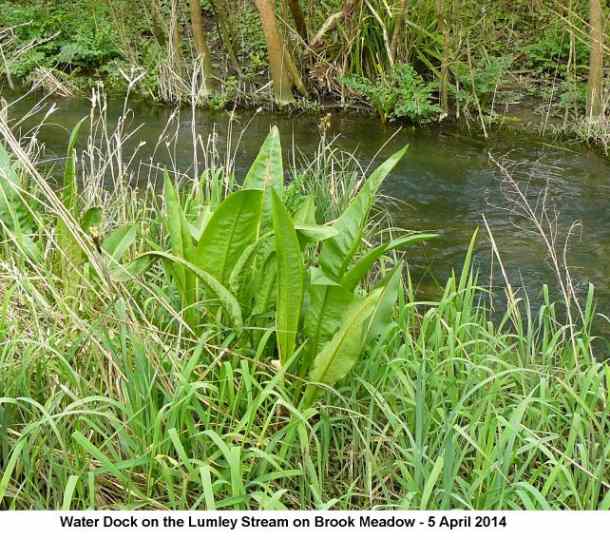
The bright leaves of
Silverweed are now prominent on the east side
of the Lumley area, but no flowers as yet.
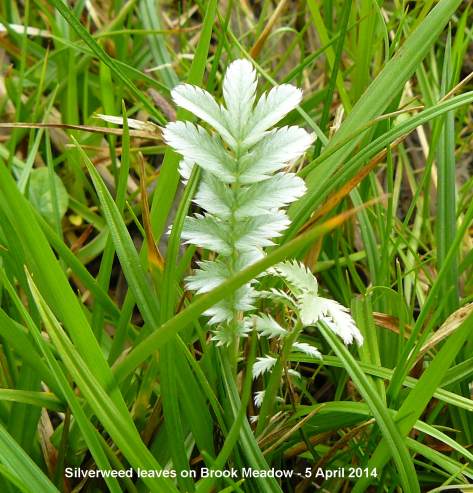
Greater Pond
Sedge is in full flower on the east side of the
Lumley area. The photo shows well the yellow anthers
on the upper male spikelets and the white stigmas on
female lower ones.
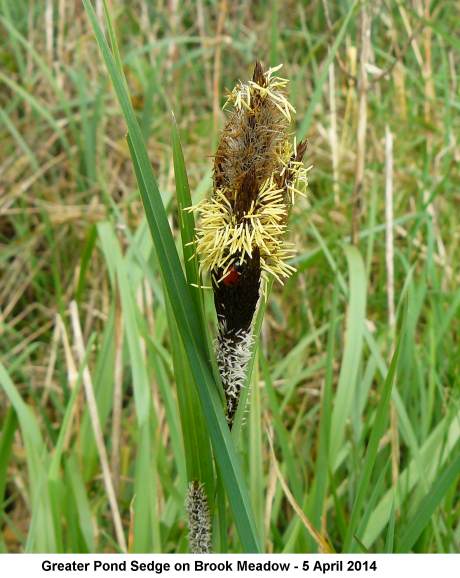
Distant Sedge
is also out on the Lumley area as well as Divided
Sedge.
Malcolm Phillips was
busy picking up a load of rubbish on the meadow today.
He also hauled three long logs from the river. Well
done, Malcolm. He still managed to get this rather
nice image of one of our resident Song
Thrushes.
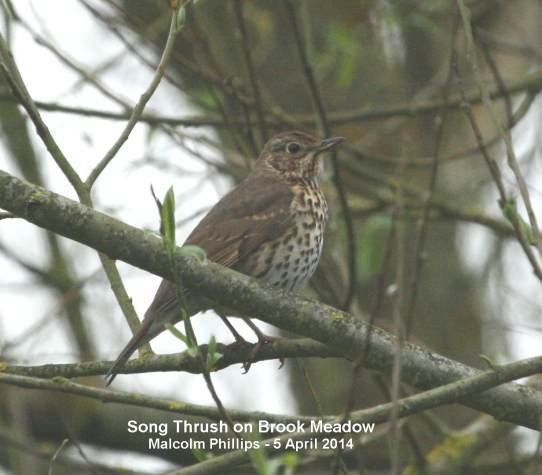
Millpond
News
A pair of Mute
Swans flew onto Peter Pond as I was passing, probably
the same pair that I saw there yesterday. The Mute
Swan was off the nest in the reedbeds on Slipper
Millpond and both swans were being fed on the west
side of the pond. There were no eggs visible in the
nest. I counted 10 Mediterranean Gulls among the
Black-headed Gulls on Slipper Millpond.
Wayside
plants
I spotted a
single plant of Wood Avens in flower on the
path behind Lillywhite's Garage.
Barnacle
Geese on Baffins Pond
Eric Eddles
was surprised to find these four Barnacle Geese
walking around the tarmac path at Baffins Pond today.
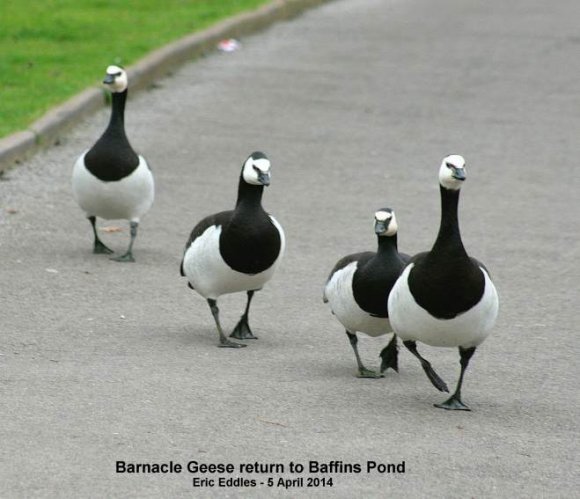
These attractive feral
geese were a common feature of the pond in 1990s and
early 2000s when I used to do my weekly surveys. They
reached a peak of 42 in the winter of 1998-99 and used
to migrate regularly to Titchfield Haven where they
were affectionately known as the "Baffins Gang".
However, numbers gradually fell away, though I believe
a pair did produce a brood of 5 on the pond in 2008.
Nowadays, I only make occasional visits to the pond,
though Eric keeps a good eye on the place as he lives
within walking distance. I have not seen any recent
reports of Barnacle Geese locally. However, I believe
there are a good number of feral Barnacle Geese on the
Isle of Wight from where these birds may have come.
Swallows
Colin Falla
and his wife spotted their first Swallow resting on a
telephone wire at West Stoke near Lavant, at 8.20 am
this morning. There have been a few local sightings,
though I have yet to see one. They are clearly moving
in and soon should be flowing through the country.
Milton
Common
Heather Mills
reported on this morning's walk by the Havant Wildlife
Group at Milton Common. Sightings included Willow
Warbler and Sedge Warbler. Full report is on the web
page at . . . http://familyfellows.com/hwg-walk-reports-2014.htm
FRIDAY
APRIL 4 - 2014
Stansted
Forest
Jean and I had
a walk round Stansted Forest (east) from the garden
centre past the Iron Gate Cottages and up the tarmac
roadway to the cottages where Sonia Bolton used to
live. We returned along the rough track to the
house.
Virtually the first bird we heard and saw was a
Raven flying overhead and kronking as it went.
This was out second Raven sighting at this spot - the
first was of a pair with a photo on Feb 26. Michael
Prior told me they are nesting on the Stansted estate.
Chiffchaffs and Blackcaps were singing throughout the
walk, but no other migrants. We heard two Mistle
Thrushes singing during the walk and saw one on the
ground near the house.
Wild flowers of interest noted included Ground-ivy,
Cherry Laurel, Bluebells (mostly in Oak Copse), a few
Cuckooflowers, Greater Stitchwort, Coltsfoot,
Primroses and Common Dog-violet.
Waysides
flowers
Cuckooflowers
are now showing well on the Bridge Road Wayside. I
counted 340 plants in flower this afternoon with more
to come. However, we have some way to go to beat the
record of 694 set in April 2012. Also out on the
Bridge Road wayside were Bay and Meadow Foxtail.
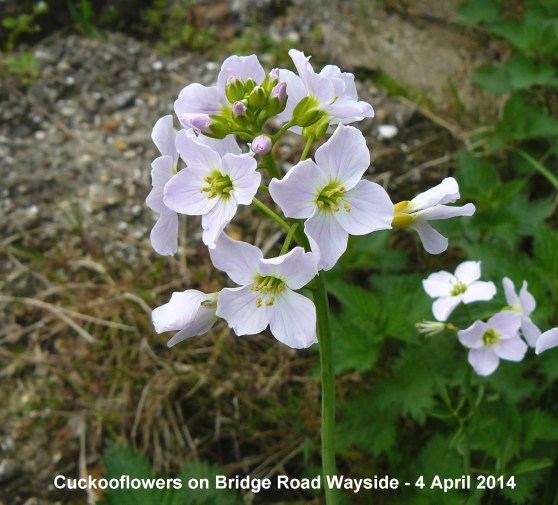
Cornsalad is flowering
again on the pavement in St James Road where I have
found it in previous years. I assume it is
Keel-fruited Cornsalad (V. carinata) which
Ralph Hollins told me is the default Cornsalad species
here in Hampshire and not Common Cornsalad (V.
locusta). Keel-fruited Cornsalad gets its name from
its deeply grooved and keeled fruits.
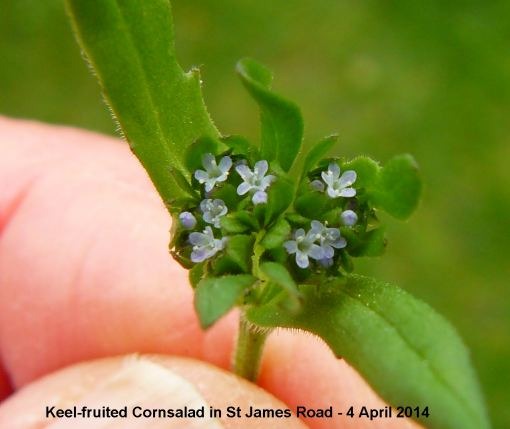
Local
bird news
The Mute
Swan nest near the bridge on the town millpond has
been totally engulfed by the incoming tide and is no
longer viable. The swan pair was on the water, but no
sign of the other pair.
Yesterday, Tony
Wootton saw his first Swallows (4), Orange Tips
(2) and Blackcaps (2) during a walk from Thorney to
Prinsted. Tony snapped the Great Black-backed Gulls
on Slipper Millpond and suggested the caption 'Are
you listening to me'.
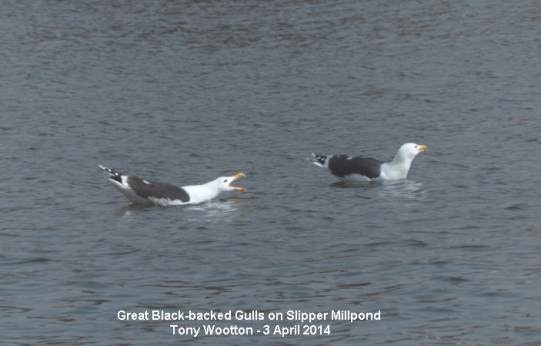
Lizard
on Brook Meadow
Yesterday (Apr
3) Malcolm Phillips got a photo of a Common Lizard on
the north meadow. This was particularly interesting in
view of the reptile survey that is currently underway
on the meadow and I shall be informing the surveyors
of the sighting.
See report below.
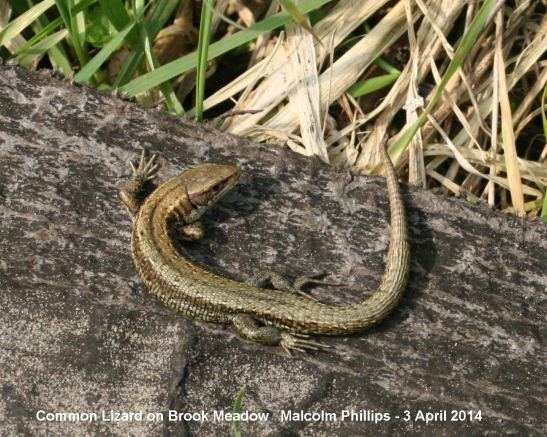
Information on the
Common Lizard
The common lizard is the UK's most common and
widespread reptile. It is found across many habitats
including heathland, moorland, woodland and grassland
where it can be seen basking in sunny spots. Variable
in colour, but usually brownish-grey, often with rows
of darker markings down the back and sides. Males have
bright yellow or orange undersides.
Adults emerge from hibernation in March, usually the
males are a few weeks earlier than the females. Mating
is between April and May. The females produce between
3 and 11 young in July, the young are born in an egg
sac that breaks either during birth or soon
afterwards. This is why the name viviparous lizard is
sometimes used, as it means bearing live young, as
opposed to laying eggs, which is more usual for
lizards.
In spring the males and females bask in the open to
absorb the heat from the sun. Later in the summer it
is usually only the pregnant females that are seen to
bask. They will often use a stone, log or grass
tussock close to cover for basking. If disturbed they
often return to their favourite spot soon
afterwards.
For more information see . . . http://www.herpetofauna.co.uk/common_lizard.htm
Brook
Meadow reptile survey
Paul Whitby of
Azure Ecology, who are conducting the survey, checked
the reptile mats on Brook Meadow on Apr 2 and found a
single Slow-worm, so there is at least a presence!
Regarding the concerns expressed over the possible
detrimental effect of the proposed introduction of
reptiles onto Brook Meadow on the resident insect
population, Paul indicated that the main prey for
Slow-worms is small slugs and not faster moving prey,
such as beetles, flies etc. Although Lizards are
insectivorous he says the impact upon the population
of the meadow would be negligible. The dynamics of the
populations of invertebrate prey and reptiles would
balance out, i.e. if the invertebrate population fell,
so would the reptile population. There would not be a
situation where the reptiles could eliminate a prey
source.aul Whitby of Azure Ecology checked the reptile
mats on Brook Meadow on Apr 2 and found a single
Slow-worm, so there is at least a presence!
Langstone
Mill Pond
Armed with his
digiscope camera setup, Peter Milinets-Raby headed for
Langstone Mill Pond to try and improve on the photos
of that female Goosander. It wasn't to be! Morning
visit via Wade Lane (10:10am to Noon - bumped into
Ralph Hollins).
Wade Lane: Chiffchaff and Blackcap both singing, 1
Buzzard, 1 Little Egret feeding in horse paddock,
Mistle Thrush, Song Thrush, 2 Stock Doves.
Paddock north of millpond: 9 Moorhen, Blackcap
singing, 1 Stock Dove,
Pond itself: Female Mute Swan off its nest for about
20 minutes (7 eggs clearly visible).
Little Egrets: 33 birds on the island, 32 birds by the
Grey Herons nests and 8 elsewhere (about 17 to 20 nest
sites at present: this number will grow.)
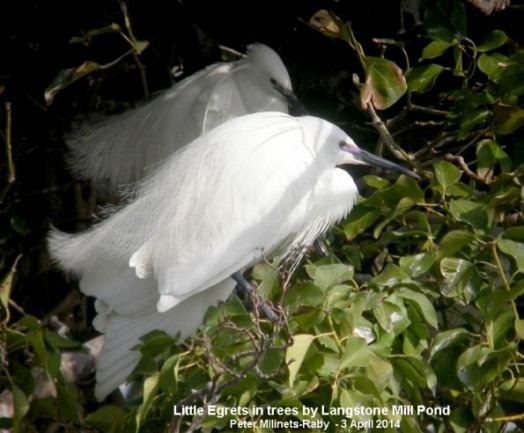
Blackcap singing from
rear of the pond. 2 Med Gulls over. Grey Herons:-
North nest - bird firmly sat down. South nest. Male
came in with a huge "branch" that the female stood up
and arranged about her.
In Channel offshore: 14 Red breasted Mergansers,
Female Goosander amongst these birds, 6 Black-tailed
Godwit, 2 Bar-tailed Godwit, 20 Shelduck, 2 Brent
Geese, Greenshank.
And this afternoon while Peter was cleaning out his
garden pond he accidentally caught a male Palmate
Newt.
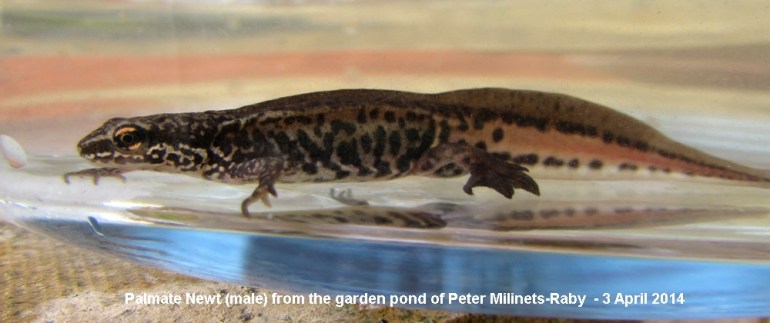
Black
Swans in UK
There is a
long standing small colony of Black Swans on the West
Ashling millpond where they sometimes breed. So it was
interesting to get the following information about
their present status in the UK from Lee Evans. Lee
says there are now at least 91 Australian Black Swans
at large in the UK and perhaps as many as 37 pairs
breeding. The majority are escapes from captivity but
young are now dispersing from core areas and
establishing new territories. There is also a sizeable
non-naturalised population in The Netherlands and Lee
feels that quite a few of our East Coast population
has arrived from there.
BTO
migration news
Wheatear, Sand
Martin and Chiffchaff were among the early-arriving
migrants that appeared on cue in March. By 24 March,
the first Osprey had reappeared at RSPB Loch Garten
and the turn of the month heralded the first wave of
Willow Warblers. There were a number of reports of
surprisingly early dates for some migrants, including
Yellow Wagtail in the first ten days of March and
three reports of Grasshopper Warbler reeling in the
same period. For the latter, at least, these
exceptionally early dates might relate to a very small
number of overwintering individuals. This was
certainly the case for a Whitethroat that wintered in
Cambridgeshire and made it through into early spring.
For more migration news, check out the BTO Migration
Blog at http://bto-enews.org/NXN-2AMGO-3GJW16-10AO3W-0/c.aspx
THURSDAY
APRIL 3 - 2014
I did my regular cycle
ride from home, through Brook Meadow, past the
Hermitage Millponds and down to North Thorney on this
warm and sunny morning.
Brook
Meadow
I met Brian Lawrence
on the meadow and as we walked down the main river
path we saw several butterflies including Comma,
Brimstone, Small Tortoiseshell and Peacock. Brian also
had an Orange Tip earlier on. We noted a large number
of Nursery-web spiders (Pisaura mirabilis) resting on
the nettle leaves, all with their legs scrunched up,
clearly not actively hunting. There were also a few
7-spot Ladybirds and one Harlequin Ladybird
with markings like I have never seen before.
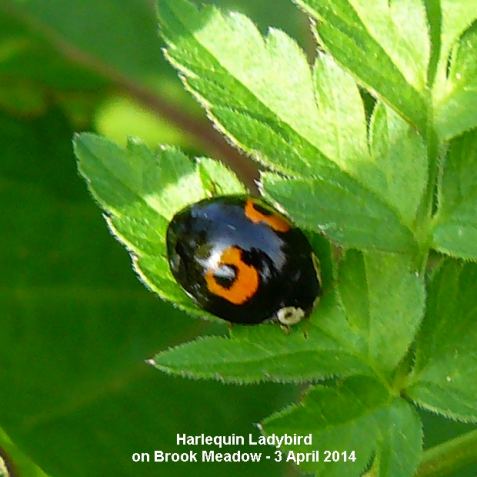
I heard two
Blackcaps singing, one on the west bank behind the
factories and the other in the south meadow near the
bramble hedge. Many of the Cow Parsley plants
along the main river path are in bud and there are a
few with open flowers.
Hermitage
Millponds
A new pair of Mute
Swans was on Peter Pond this morning. This is not
the same pair that was on the pond briefly on Feb 26
since one of those swans had a metal ring on its left
leg. Neither of today's swans had a ring. It will be
interesting to see if they stay and attempt to nest
now Peter Pond has been vacated by its regular nesting
pair.
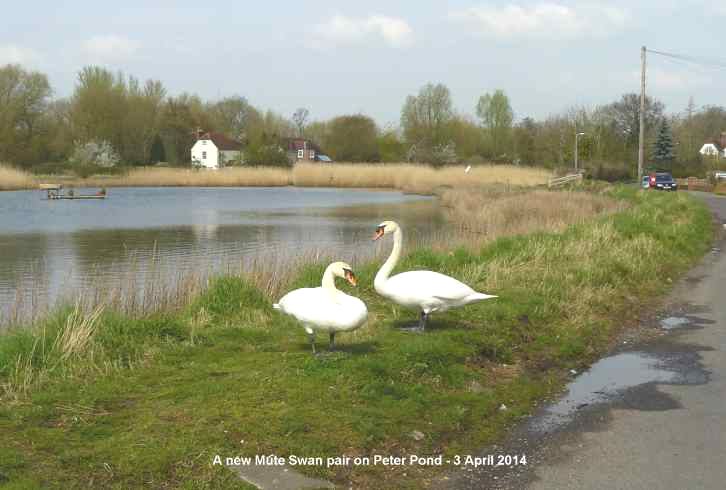
The regular Mute Swan
pair was on Slipper Millpond, with the pen now
snuggled down on her new nest in the north west
reedbeds and the cob on the water. The nest has been
built up since I saw it last and now looks quite
substantial. The pair of Great Black-backed
Gulls was on the water. The south raft has had an
extra structure added to deter the gulls from nesting
there, though this would be unlikely due to its small
size.
One new flower was out - Garlic Mustard in the
area behind the reedbeds where the swan is nesting.
North
Thorney
There is no sign of
any swan nest on the marina seawall as there has been
in previous years. I met Barry Collins on the marina
seawall. He had just seen a Swallow while walking
along the old NRA track. I walked along there myself,
but did not see anything apart from a Moorhen chick in
the flooded field to the north of the track - my first
of the year. There was a new pair of Mute Swans on the
Deckhouses Estate pond.
Mystery
sedge
I had another look at
the mystery sedges on the edge of the old NRA track.
Most of the plants have relative short bracts as
required by Divided Sedge, however, many of them have
much longer bracts than would be expected from this
sedge. I first noted these unusual sedges on April 1st
and sent a photo of one of the inflorescence showing
the long bract to Martin Rand.

He did not think it
was Carex divisa as it appeared to have female flowers
at the top of the terminal spike. He asked me to check
this which I did and, yes, the flowers were all
female, ie, they had stigmas not anthers. The terminal
spike in Carex divisa should have male flowers with
female flowers lower down. I looked at some of the
lower flowers and they all seem to be female as well.
Martin also thought the green midrib on the glume
looked rather too prominent, but this may have been
due to the young stage of growth. He added that the
lowest bract length is very variable in this species
and can be considerably longer than the inflorescence.
I collected another couple of samples which I will
send on to Martin for his close inspection.
WEDNESDAY
APRIL 2 - 2014
Langstone
Mill Pond
Peter Milinets-Raby
was at Langstone Mill Pond this morning (10:40am to
11:40am - grey day, south wind, drizzle just finished
- tide pushing in).
On the mud as the tide pushed in were: 11 Brent Geese,
17 Shelduck,, 43 Black-tailed Godwits which alas soon
flew off to the north Hayling shore (probably with
coloured rings, but they flew off before I could go
through them), 4 Red Breasted mergansers, Greenshank
(coloured ringed, same as the other day
G-R/BRtag).
On the pond: Female Goosander again preening and
swimming at the rear of the pond.
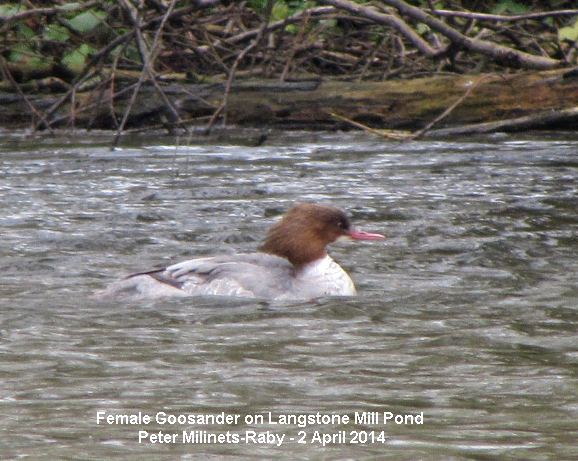
Little Egrets: Very
busy with several birds observed today collecting
twigs and sticks. On the island (best viewed from the
back of the Mill) there are 7 to 8 nest sites. And on
the trees with the Grey Herons there are 8 to 9 nest
sites. Still early in the season, I'm sure more will
nest, though the island looks thinner than last year
(I think a few trees have fallen down). Grey Herons:
Firmly on nests, not doing much.
Mute Swans: Male out in the harbour, so the duck were
having a great time coming to bread. Female on
nest.
Paddock/pony field/ancient cricket pitch north of
pond: 7 Moorhen
Bullfinches
in garden
Patrick Murphy had
male and female Bullfinches in his North Emsworth
garden - lucky chap. Here is a photo of the female.
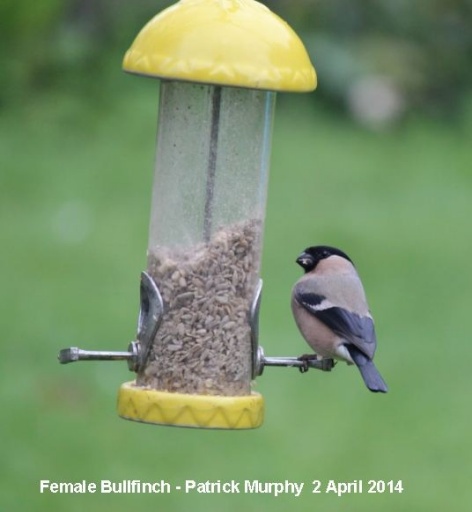
Hayling Oysterbeds news update
Chris Cockburn
provided the latest news on the new breeding season at
Hayling Oysterbeds:
"It looks as if nesting might be earlier at the
Hayling Oysterbeds this year - today, the first
black-headed gull nest-building attempt was seen on
West Island (between pegs F & G - but nearer to
G). Plenty of Mediterranean gulls still strutting
about on the lagoon islands and a few Sandwich terns
have been flying over the site during the high tide
period. The 2 or 3 pairs of the lagoon's resident
oystercatchers are unlikely to nest successfully
unless they can become as aggressively territorial as
the gulls (leaving your egg-filled nest unguarded is
not a good strategy) nor is nesting below the
mean-springs high tide level (unfortunately, the
lagoon islands rarely have helpful strandlines to
inform the birds).
The recent coincidence
of light breezes and sunny weather during the high
tide period has resulted in many gulls taking up
territories on South Binness & Round Nap Islands
plus a few, apparently, considering Long Island's
shingle ridge. If their behaviour corresponds with
previous seasons, they will probably start egg-laying
at the end of April (3 or 4 weeks later than the
Oysterbeds' birds). The nest counts on South Binness
& Round Nap are likely to take place in the week
of 12th May to 16th May and Thursday 15th May is
probably the ideal date - weather permitting.
The tides have been
surging slightly, despite the benign weather
conditions - but nowhere near as damaging as the
recent winter surges. This effect appeared to have
caused a slight delay to the RSPB's shingle recharge
that is taking place on Baker's Island (on Monday, the
excavator was unable to reach the submerged shingle
bags on the peak of the tides). Let's hope that the
little terns appreciate the RSPB's efforts to save
them and that they, the little terns - not the RSPB -
have a successful breeding season.
TUESDAY
APRIL 1 - 2014
North
Thorney
11:00 - I walked along
the old NRA track. With the sun shining and songs of
unseen Cetti's Warblers exploding from the bushes, it
was just like being in Mallorca! There was no sign of
any Swallows though I did hear several Chiffchaffs and
a single Blackcap. Plenty of Mediterranean Gulls were
flying over, calling as they went. I noticed some
sedges in a wet area on the northern edge of the track
which I think must be Divided Sedge, even though the
inflorescences were more substantial than I would have
expected and some plants had exceptionally long
bracts.

I walked down to
Little Deeps where Little Grebes were whinnying, but
no sight or sound of any migrants. Spider's webs were
draped over the reeds shining with droplets of
moisture from the heavy mist. I did not realise that
spiders wove their webs this early in the season. Not
much to catch in the way of insects? I walked back
through the old Marina Farm which was horrendously
muddy near the stables.
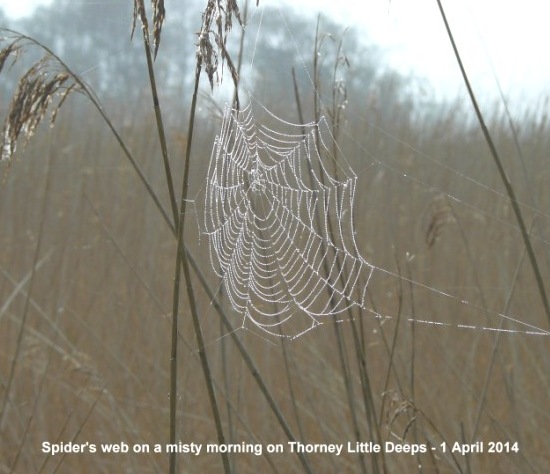
Hermitage
Millponds
12:00 - The pen swan
was on the water on Slipper Millpond which meant I was
able to get a good look at the nest in the reeds. It
is fairly rudimentary and has not yet been lined and
there were no eggs in it. The cob swan was over on
Peter Pond. There is a Coot 'tower nest' on the edge
of the reeds on the western side of Peter Pond, which
should be safe from the spring tides. It looks as if
there is another Coot nest in the process of
construction on the floating raft. So with the nest on
the north reedbeds there are at least three Coot nests
on Peter Pond.
Plant
news
I have confirmed the
identification of Common Dog-violet on the
Lillywhite's path wayside. It has long-stalked cordate
leaves, two narrow stipules with stipule teeth,
pointed sepals with square-cut appendages and spurs
curved and blunt with notch at the tip. It grows on
the verge near the brick wall, a little further west
than the Sweet Violets, which flowers much earlier and
now shows just large fleshy leaves.
Meadow Foxtail
grass which I recently found out on the Westbourne
Open Space wayside is now out on the Lumley area of
Brook Meadow. This is the right time, though is 3
weeks earlier than last year which was very late due
to the cold spring.
Other
news
Robin Pottinger saw
his second Water Vole of the year this morning
at about 11.45. It was swimming south through
vegetation on east side just opposite the bay tree
behind gasholder. That was a particularly good
sighting as it occurred in an area where we have had
only 3 previous sightings this year - Section B.
Malcolm Phillips
captured this image of a Coal Tit in a Yew tree
in his Emsworth garden today.
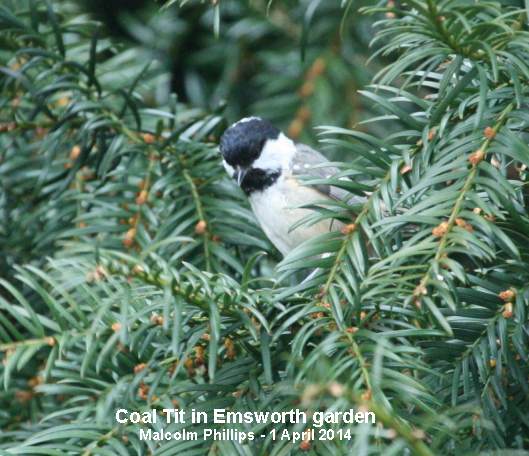
Tony Wootton sent me the following photo of 5 Brent
Geese, one adult and 4 juveniles, flying westward
at Keyhaven yesterday - probably on their way back to
the breeding grounds in the High Arctic. As Tony says
this shows that juveniles keep their white wing
markings even though they are nearly a year old by
now. But they will have lost them by the time they get
back in the autumn, replaced by a fresh lot of
youngsters we hope.
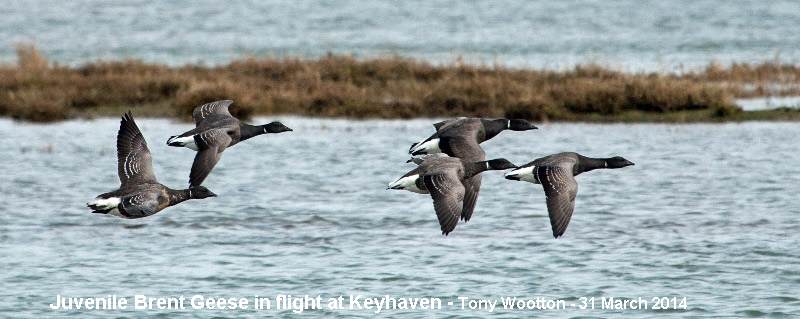
For
earlier observations go to . . March
17-31